# EDDF - Frankfurt/Main Airport
# EDDF - Overview
Frankfurt/Main airport is one of the largest airports in Europe and the world. Together with London Heathrow, it is also the busiest airport on the VATSIM network.
**All stations at Frankfurt require a Tier 1 endorsement ([mentoring session necessary](https://training.vatsim-germany.org/ "Training Request Thread")).** DEL and GND positions require the EDDF\_GNDDEL endorsement which can be acquired by all controllers with an **S1** rating or higher. TWR requires the EDDF\_TWR endorsement which can be acquired by all controllers with an **S2** rating or higher. All APP/DEP positions require the EDDF\_APP endorsement which can be acquired by all controllers with an **S3** rating or higher.
**Training:** Controllers with the S1 rating can staff TWR positions during their training (active EDDF\_TWR solo endorsement required). Controllers with the S2 rating can staff APP/DEP positions during their training (active EDDF\_APP solo endorsement required).
### Frankfurt/Main ATC Stations
| **Station**
| **Station ID**
| **Login**
| **Frequency**
| **Remark**
| **Endorsement**
|
| **DEP-ATIS**
| ADDF
| EDDF\_D\_ATIS
| 118.730
| --
| --
|
| **ARR-ATIS**
| AADF
| EDDF\_A\_ATIS
| 118.030
| --
| --
|
| **Delivery**
| DFC
| EDDF\_DEL
| 122.035
| --
| Tier 1: [EDDF\_GNDDEL](https://core.vateud.net/my/endorsements "Your endorsements (VATEUD Core)") |
| Coordinator
| --
| EDDF\_CO\_DEL
| --
| event position, monitors 122.035
| Tier 1: [EDDF\_GNDDEL](https://core.vateud.net/my/endorsements "Your endorsements (VATEUD Core)") |
| **Apron**
|
| **Center Apron**
| DFGC
| EDDF\_C\_GND
| 121.855
| primary
| Tier 1: [EDDF\_GNDDEL](https://core.vateud.net/my/endorsements "Your endorsements (VATEUD Core)") |
| **West Apron**
| DFGW
| EDDF\_W\_GND
| 121.755
| secondary
| Tier 1: [EDDF\_GNDDEL](https://core.vateud.net/my/endorsements "Your endorsements (VATEUD Core)") |
| East Apron
| DFGE
| EDDF\_E\_GND
| 121.955
| tertiary
| Tier 1: [EDDF\_GNDDEL](https://core.vateud.net/my/endorsements "Your endorsements (VATEUD Core)") |
South Apron
| DFGS
| EDDF\_S\_GND
| 121.655
| not yet used in reality
| Tier 1: [EDDF\_GNDDEL](https://core.vateud.net/my/endorsements "Your endorsements (VATEUD Core)") |
| Deicing
| DFGI
| EDDF\_ICE\_GND
| 121.985
| --
| Tier 1: [EDDF\_GNDDEL](https://core.vateud.net/my/endorsements "Your endorsements (VATEUD Core)") |
| **Tower / Ground**
|
| **Center Tower**
| DFTC
| EDDF\_C\_TWR
| 118.780
| primary
| Tier 1: [EDDF\_TWR](https://core.vateud.net/my/endorsements "Your endorsements (VATEUD Core)") |
| **West Tower**
| DFTW
| EDDF\_W\_TWR
| 124.855
| secondary
| Tier 1: [EDDF\_TWR](https://core.vateud.net/my/endorsements "Your endorsements (VATEUD Core)") |
| North Tower
| DFTN
| EDDF\_N\_TWR
| 136.500
| tertiary
| Tier 1: [EDDF\_TWR](https://core.vateud.net/my/endorsements "Your endorsements (VATEUD Core)") |
| South Tower
| DFTS
| EDDF\_S\_TWR
| 119.905
| --
| Tier 1: [EDDF\_TWR](https://core.vateud.net/my/endorsements "Your endorsements (VATEUD Core)") |
| Supervisor
| --
| EDDF\_CO\_TWR
| --
| event position, airport-wide flow control and decision making
| Tier 1: [EDDF\_TWR](https://core.vateud.net/my/endorsements "Your endorsements (VATEUD Core)")
|
| Ground
| DFG
| EDDF\_GND
| 121.805
| --
| Tier 1: [EDDF\_GNDDEL](https://core.vateud.net/my/endorsements "Your endorsements (VATEUD Core)") |
| **Arrival / Departure**
|
| **North Approach**
(Pickup)
| DFAN
| EDDF\_N\_APP
| 120.805
| primary arrival
| Tier 1: [EDDF\_APP](https://core.vateud.net/my/endorsements "Your endorsements (VATEUD Core)")
|
| South Approach
(Pickup)
| DFAS
| EDDF\_S\_APP
| 125.355
| --
| Tier 1: [EDDF\_APP](https://core.vateud.net/my/endorsements "Your endorsements (VATEUD Core)") |
| **North Arrival**
(Feeder)
| DFANT
| EDDF\_H\_APP
| 127.280
| primary feeder
| Tier 1: [EDDF\_APP](https://core.vateud.net/my/endorsements "Your endorsements (VATEUD Core)") |
| South Arrival
(Feeder)
| DFAST
| EDDF\_L\_APP
| 118.505
| --
| Tier 1: [EDDF\_APP](https://core.vateud.net/my/endorsements "Your endorsements (VATEUD Core)") |
| North Departure
| DFDN
| EDDF\_N\_DEP
| 120.155
| --
| Tier 1: [EDDF\_APP](https://core.vateud.net/my/endorsements "Your endorsements (VATEUD Core)") |
| **South Departure**
| DFDS
| EDDF\_S\_DEP
| 136.130
| primary departure
| Tier 1: [EDDF\_APP](https://core.vateud.net/my/endorsements "Your endorsements (VATEUD Core)") |
### CTR Frankfurt/Main
[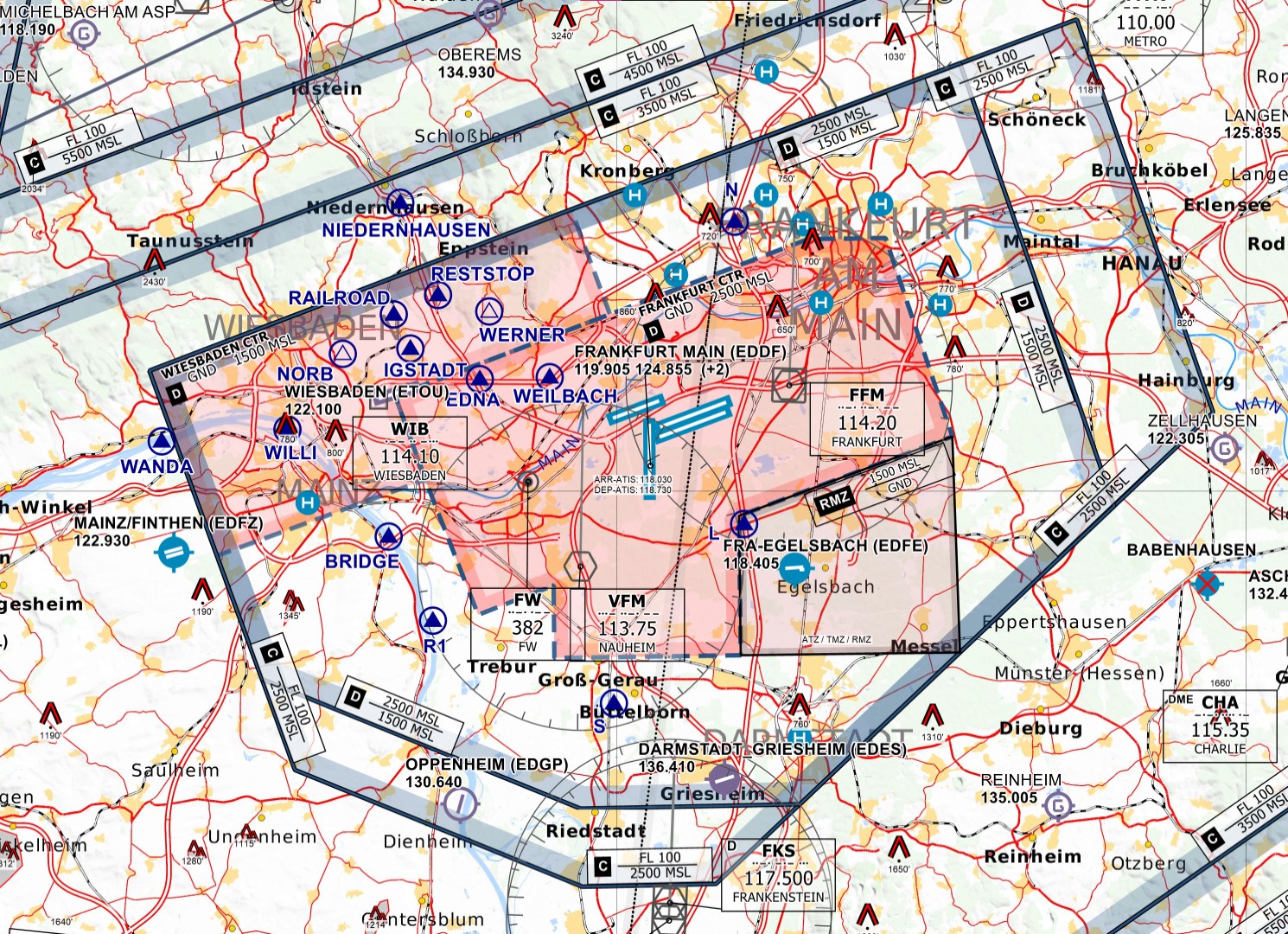](https://knowledgebase.vatsim-germany.org/uploads/images/gallery/2024-03/eddf.jpg)
*Frankfurt/Main D-CTR - © [openflightmaps.org](https://www.openflightmaps.org/)*
### Airport Capacity
| **Outbound EDDF** | **Inbound EDDF** |
|---|
| **RWY 18** | 40 / hr
every 2 min
+ 10 extra movement | **alternating** | 35 - 40 / hr |
| **RWY 25C / 25L** | 25 / hr
every 3 min
+ 5 extra movement | **parallel independent** | 50 - 60 / hr |
| **RWY 07C / 07R** | 40 / hr
every 2 min
+ 10 extra movement | **single runway** | 25 - 30 / hr |
| **Sector Arrival South (DFAS)**: 8 - 10 aircraft at the same time |
| **Sector Arrival North (DFAN)**: 10 - 12 aircraft at the same time |
- **RWY 25:** 10 - 12 active startup approvals at the same time
- **RWY 18/07:** up to 15 active startup approvals at the same time
# EDDF - Delivery
Frankfurt Delivery is responsible for enroute and startup clearances for all departing IFR aircraft. VFR aircraft have to call Delivery for departure information. Information about VFR squawk codes at EDDF can be found in the Tower chapter. For all departures (IFR and VFR) Frankfurt Delivery is the first station to contact.
**Startup:** Startup will normally be given when the pilot is ready for pusback and startup and not together with the IFR clearance. When startup clearance cannot be given immediately or the pilot is not ready for startup within the next 5 minutes during high traffic situations, the pilot needs to stay on Delivery frequency until he receives startup clearance. If an expected startup time (TSAT) exists, the pilot should be informed about it. This procedure might be necessary during events with a lot of outbound traffic.
**Maximim active Startup Approvals** at the same time (status SUG until DEP) per runway (use the vSID startup counter):
**RWY 25:** 10 - 12
**RWY 07/18:** 15
Depending on the traffic situation, only for a short time more startup approvals shall be used.
With startup Delivery transfers the aircraft to the responsible Apron station depending on the current stand.
**Events:** For events Delivery has a very important role regarding the efficient traffic flow at the airport and runways. Check the usage of slots as well as the Event Coordinator article for more information. During events startup should only be issued when the outbound is ready for pushback within the next 5 minutes. Otherwise clearance can already be given and the pilot needs to report ready for startup on Delivery frequency.
### SID Assignment
The runway used for departure and the corresponding SID are based on the first waypoint of a flight plan. Outbounds to the north (MARUN, OBOKA, TOBAK) will use runway 25C/07C by default. Departures to the east, south and west (SULUS, CINDY, ANEKI, SOBRA, ULKIG) will get runway 18 for departure. There is only one exception of that during 07 operations, where outbounds to the east (SULUS / KOMIB) will also use runway 07C.
**South Apron:** Aircraft parked in the southern part of the airport can be told to prepare both runways (25C/07C and 07R/25L), final decision will be by Tower later on during taxi depending on inbound traffic. This should be noted in the remark section (e.g. "25C/25L"). During low traffic situation, runway 25L/07R can be issued directly.
The default SID designator for each runway and waypoint can be seen in the table below.
| **Waypoint** | **RWY 25C** | **RWY 18** | **RWY 07C** |
| **ANEKI** | - | L | - |
| **CINDY** | - | S | - |
| **KOMIB** | - | - | D |
| **OBOKA** | M / G | - | E / D |
| **MARUN** | M / F | - | E / D |
| **SOBRA** | - | L | - |
| **SULUS** | - | S | D |
| **TOBAK** | M / F | - | D |
| **ULKIG** | - | L | - |
*[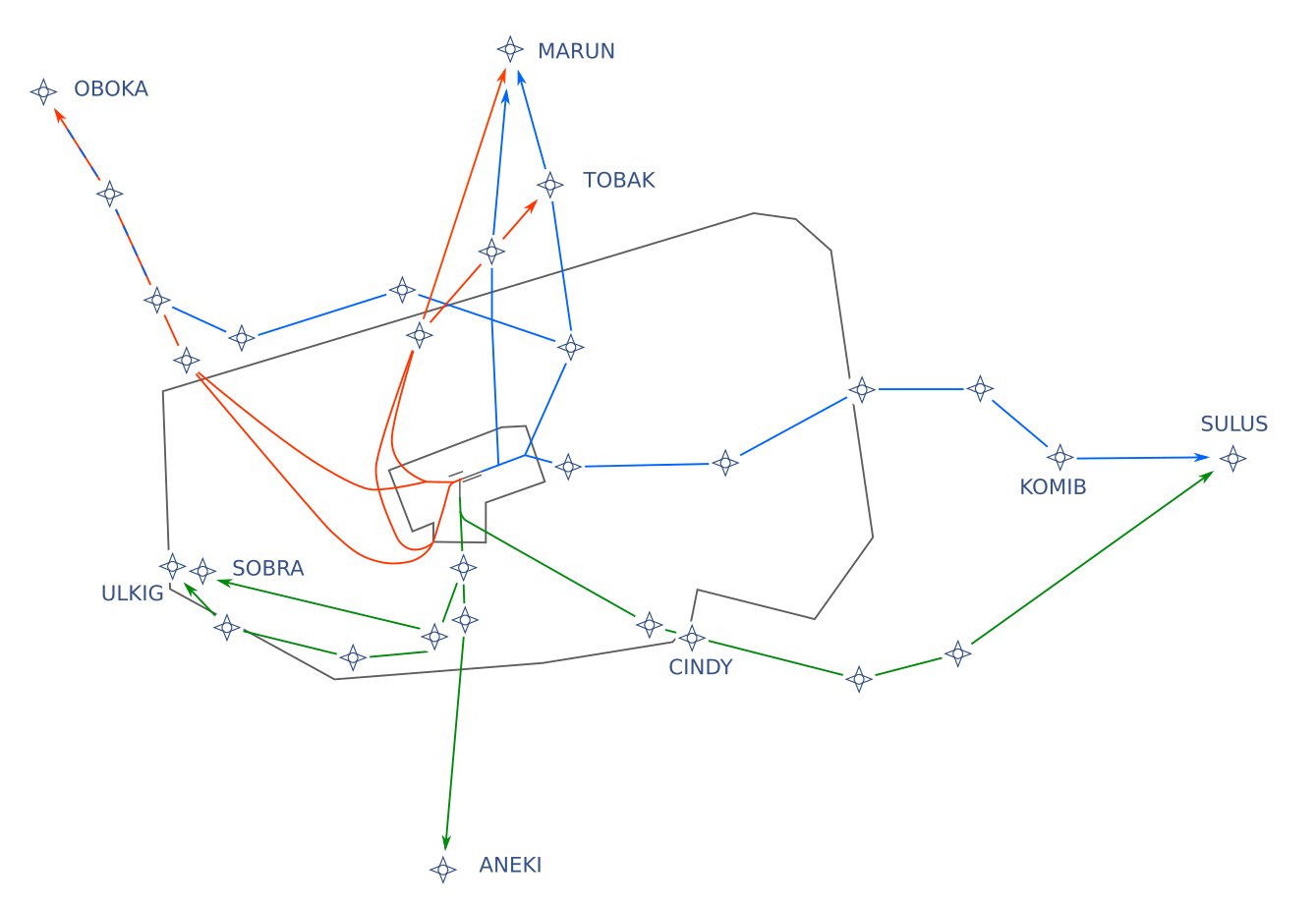](https://knowledgebase.vatsim-germany.org/uploads/images/gallery/2022-07/eddf-sid-waypoints.png)Location of waypoints that are available for flights out of Frankfurt*
For a quick overview the **[Quicksheet for EDDF](https://dms.vatsim-germany.org/s/xKbC3HDGMj4Ae2E)** includes all assignment rules.
The Quicksheet includes all useful SIDs outbound EDDF, with the ones for standard operation set in bold font. For deviation from these rules, **coordination between** **Delivery and the Tower** controllers is required, as he is responsible for the departure sequences. Be advised that non-standard SIDs can create dependencies to other arrivals and departures. **Exemption:** Departures in brackets can be cleared **without prior coordination** when filed or requested by a pilot.
For almost all SIDs, **no** coordination with APP is required as the routes are designed in a way that they don't affect the inbounds. Only the Non-RNAV-SIDs (Q/C/B) as well as R/T SIDs from runway 18 need prior coordination with APP
Especially during high workload for TWR default SIDs have to be used. If necessary the pilot's filed route has to be amended by Delivery (often a complete new route is required).
Additonally you can use the **[SOP-Quicksheet for EDDF](https://dms.vatsim-germany.org/s/rJCQS6FLB9fwk6s)** as a reference (this is by no means the entire SOP but covers the most important procedures)
### Departure Routes
#### Runway 25C/25L
**M/H/W/K-Departures:** Runway 25C/25L is primarily used for northbound flights. All aircraft except 2-engine Heavies are always assigned the M/H-Departures (so called "Südumfliegung") by default. After departure they lead with a left turn towards the south before turning to the north. This is for two reasons: Noise abatement for cities directly west of the airport and to avoid conflicts with 25R missed approaches. If the above mentioned aircraft types are not able to fly this departure route (e.g. they cannot comply with the climb restriction), they need to use the F and G-Departures.
W and K departures have exactly the same flight path as M/H departures but they require special equipment (RNP + fixed radius). Therefore they will only be assigned when filed in the flight plan or requested by the pilot. Coordination with TWR / APP is not necessary because of the identical flight path.
**F/G-Departures:** Heavies with 2 engines will get a departure route with Designator F/G and turn directly north after take-off (deviations due to weather possible). Non-standard departures towards the south that use runway 25C/25L (e.g. to save taxi time) will also use Designator F (e.g. CINDY\_F).
**N/P-Departures:** Night Departures with Designator N shall be used for all 3- and 4-engined Heavy and Super aircraft between 2200-0700LT. Single- and Twin-Props may use Designator P to SOBRA instead of runway 18.
**Low Visibility Operations:** During LVO all departing traffic that is able to fullfill the climb restriction (including two engined heavies) out of runway 25C/25L should get the M/H SIDs due to restrictions with approaching traffic.
#### Runway 07C/07R
**E/D-Departures:** Runway 07C/07R is used for north- and eastbound flights. Light and Medium aircraft are assigned a departure with Designator E, if available. Heavy and Super aircraft are assigned a departure with Designator D. Non-standard departures to the south from runway 07C (e.g. due to tailwind on runway 18) will also use Designator E/D (e.g. ANEKI\_E).
Between 2200-0700 LT all flights towards the north and east should get Designator D due to noise abatement.
**SULUS-Departures:** During 07 operations departures to the east (SULUS, KOMIB) are sent only via runway 07C/07R and not via runway 18.
**X/Y-Departures:** Designator X and Y are only available for departures to the south and west and for aircraft with special equipment (RNP + fixed radius). They should not be used.
#### Runway 18
In standard configuration runway 18 is used for outbound flights to the south (ANEKI, CINDY), west (SOBRA, ULKIG) and east (SULUS, KOMIB). SIDs with Designator S and L should be used according to the table above. S is always the shorter routing, while L is the one used if someone cannot comply with the restrictions on the S route (exception: ULKIG#L shall be preferred). SOBRA#U can be used when filed while all other SIDs with designator R and T shall not be used. During 07 operations runway 18 is not used for flights to SULUS / KOMIB.
During 25 operations, aircraft parked in the west or south can use non-standard departures from runway 18 to save taxi time (OBOKA\_S, MARUN\_S, TOBAK\_S). During 07 operations, runway 18 instead of runway 07 shall **NOT** be assigned due to conflicts with inbound traffic.
### Datalink Clearance (PDC/DCL)
At Frankfurt Airport we offer Datalink Clearance to the pilots throughout the **[Hoppie System](https://www.hoppie.nl/acars/)** and the Topsky Plugin. The airport code EDDF should be used (already preselected).
An example of the DCL message the pilot will receive can be seen below. **Startup option in the DCL window need to be set to "YES" when startup should be approved via Datalink.** By default every outbound has to call Delivery for startup.
Other DCL messages can be enabled within the Topsky CPDLC settings file manually.
CLD 2042 220117 EDDF PDC 026 SAS461L CLRD TO EKCH OFF 25C VIA MARUN7M SQUAWK 2037 ADT MDI NEXT FREQ 122.035 ATIS H REPORT READY ON 122.035
### Additional Information
#### vSID Rules/Areas
The following alias commands (.command**<space><enter>**) can be used to toogle vSID rules/areas.
| **Alias** | **vSID Command** | **Description** |
| **.south** | .vsid area eddf south | all northbound outbounds parking in the south will get runway 25L/07R for departure
|
| **.east25** | .vsid area eddf east25 | all outbounds parking east of N5 will get runway 25C for departure
|
| **.west18** | .vsid area eddf west18 | all outbounds parking west of N11 will get runway 18 for departure
|
| **.gat18** | .vsid area eddf gat18 | all outbounds parking at the new GAT will get runway 18 for departure
|
| **.sulus18** | .vsid rule eddf sulus18
| all SULUS outbounds via runway 18 instead of runway 07C/07R
|
| **.allnorth** | .vsid rule eddf allnorth | all outbounds to the north will get F/G departures out of runway 25C
|
| **.night** | .vsid night eddf | **disable** night SIDs (enabled by default)
|
| **.lvp** | .vsid lvp eddf | no F/G departures out of runway 25C
|
#### Old SIDs
Over time several SIDs have been replaced. New controllers might not know the old ones that a pilot with an older AIRAC cycle could have in his database. If someone only has an outdated AIRAC cycle, the old SIDs could be used instead of a vectored departure. You will find the current equivalents in the table below.
| **Old Waypoint** | **Current Waypoint** | **Route to use in case of old AIRAC** |
|---|
| **BIBTI** | OBOKA | **BIBTI #M/#G or #E/#D SID** |
| **DKB** | CINDY | **DKB #S SID** for CINDY Z74 HAREM T104 DKB |
| **NOMBO** | CINDY | **NOMBO #S SID** for CINDY Z74 LAMPU DCT NOMBO |
| **RATIM** | CINDY | **RATIM #S SID** for CINDY L603 RATIM (Prop only) |
| **ROTEN** | CINDY | **ROTEN #S SID - ROTEN #T STAR** (DEST EDDN only) |
| **AKONI** | CINDY | **AKONI #S SID** for CINDY SID |
#### SID Restrictions
Due to a lot of different route planning tools, some non valid routes out of Frankfurt exist. To ensure an efficient operation within the upper and lower airspace several restrictions should be met if workload permits. To solve the issue, usually **a completely new route has to be filed!** Therefore **[grd.aero-nav.com](https://grd.aero-nav.com)** can be used. All restrictions can be found in the table below.
| **Waypoint** | **Restriction** | **Remark** |
| **ANEKI** | **not** for DEST EDDM + EDMM FIR | reroute via CINDY |
| **CINDY / KOMIB** | EDDN only: CINDY mandatory during 25 ops,
KOMIB mandatory during 07 ops | reroute if wrong waypoint in FPL |
| **CINDY** | via CINDY \[...\] **T104** \[...\] DEST EDDM, EDDN only | reroute for other DEST required |
| **CINDY** | via CINDY **L603** \[...\] Prop only, max. FL230 | reroute for non prop |
| **TOBAK** | **not** via TOBAK Z10 \[...\] | reroute via MARUN |
| **MTR / TAU / FKS** | NON-RNAV only, max. FL90 | reroute for RNAV capable aircraft (e.g. A320, B738) |
# EDDF - Apron/Ground
Frankfurt **Apron** can be split into 4 stations as shown in the table and images below. Additionally, there exists a **Ground** station which will always be taken over by Tower though if not staffed.
If more than one of these stations is staffed, Delivery needs to be staffed first. If just one Apron is online, this Apron takes over all other Apron stations, but not Frankfurt Ground.
| **Station**
| **Station ID**
| **Login**
| **Frequency**
| **Remark**
|
| **Center Apron**
| DFGC
| EDDF\_C\_GND
| 121.855
| **primary**
|
| **East Apron**
| DFGE
| EDDF\_E\_GND
| 121.955
| **secondary**
|
| **West Apron**
| DFGW
| EDDF\_W\_GND
| 121.755
| will be taken over be DFGC if not staffed
|
| **South Apron**
| DFGS
| EDDF\_S\_GND
| 121.655
| will be taken over by DFGE if not staffed
not yet operational in the real world
|
| Deicing
| DFGI
| EDDF\_ICE\_GND
| 121.985
| deicing operations only
|
| Ground
| DFG
| EDDF\_GND
| 121.805
| will be taken over bei DFTS if not staffed
|
[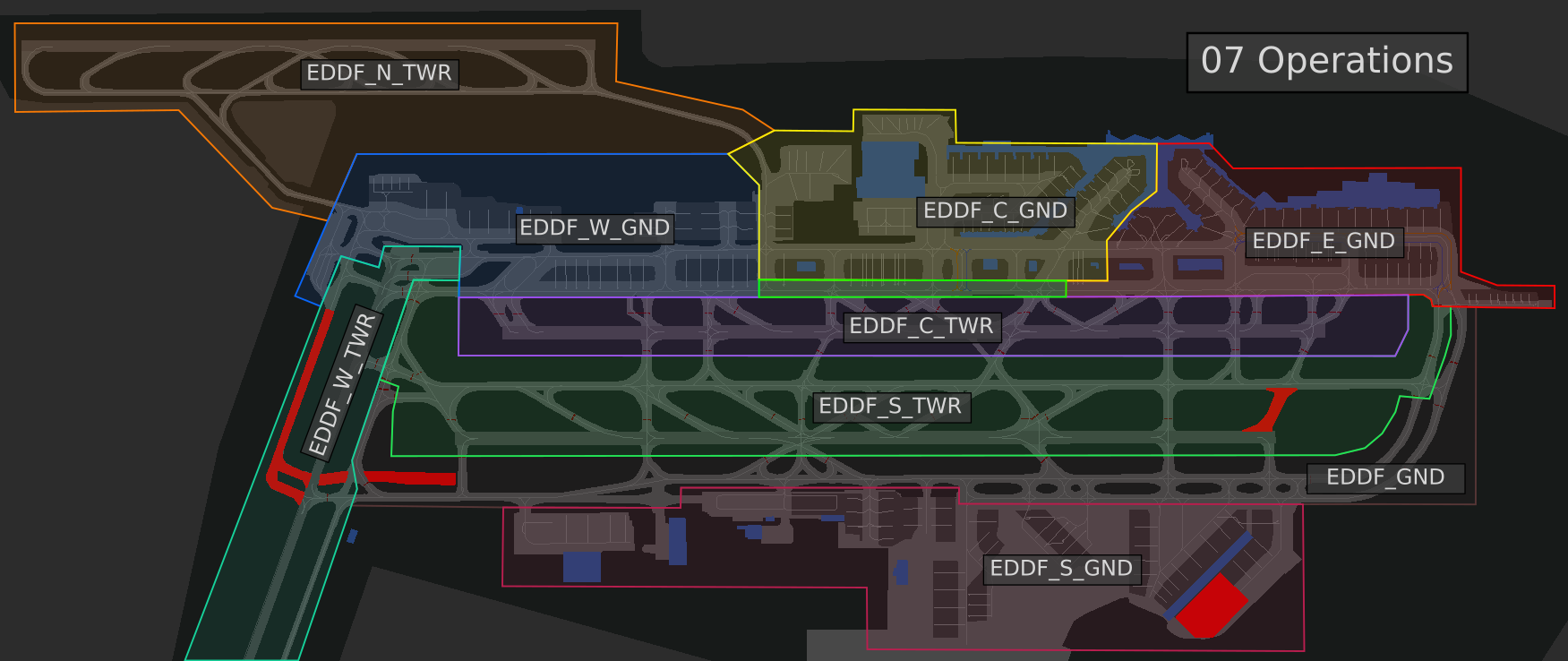](https://knowledgebase.vatsim-germany.org/uploads/images/gallery/2022-07/eddf-aor-twr-07.png)*AoR for 07 operations*
[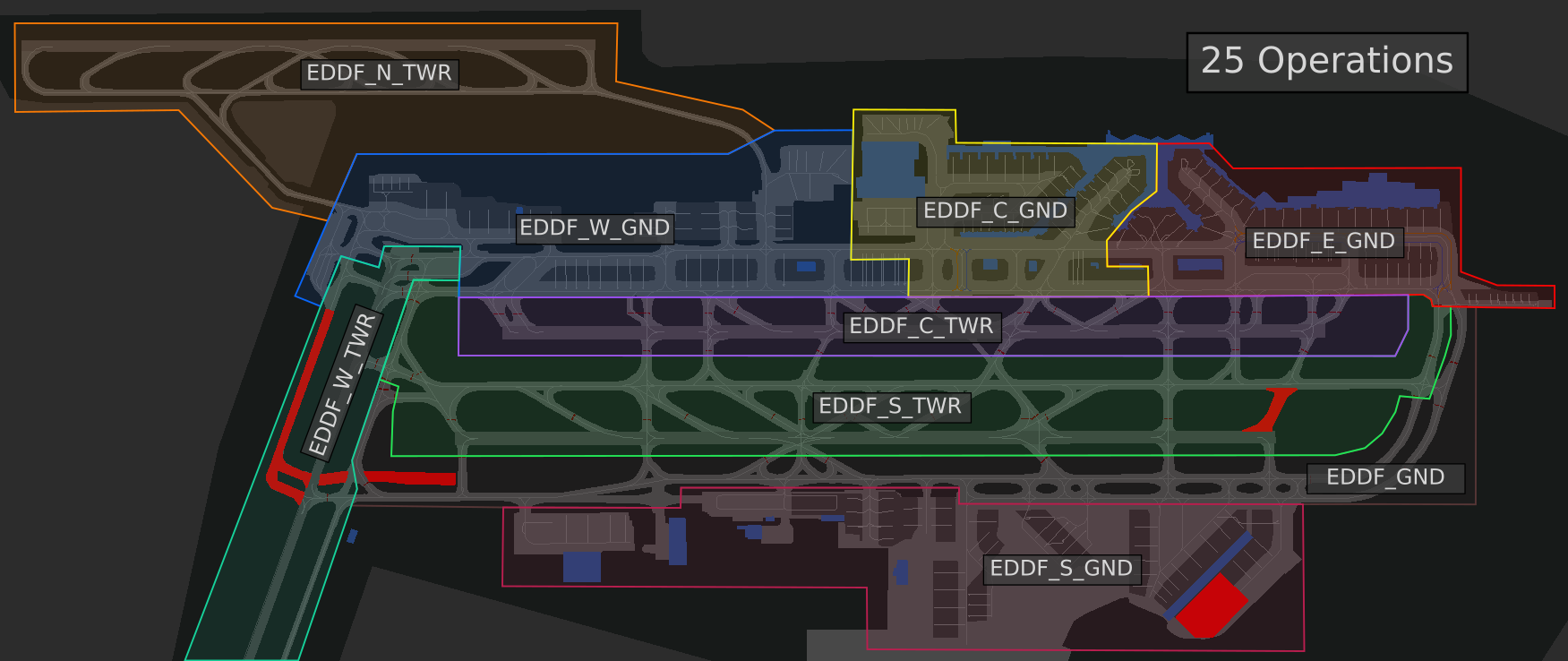](https://knowledgebase.vatsim-germany.org/uploads/images/gallery/2022-07/eddf-aor-twr-25.png)*AoR for 25 operations*
### General Procedures
#### Taxiway Usage
Taxiway L is always used in the direction towards the holding point of the center runway, depending on runway in use. Taxiway N is used the other way (see image). During 07 operations taxiway N west of N11 is also used towards the west, which shall be used for runway 18 outbounds (L, N14, N).
[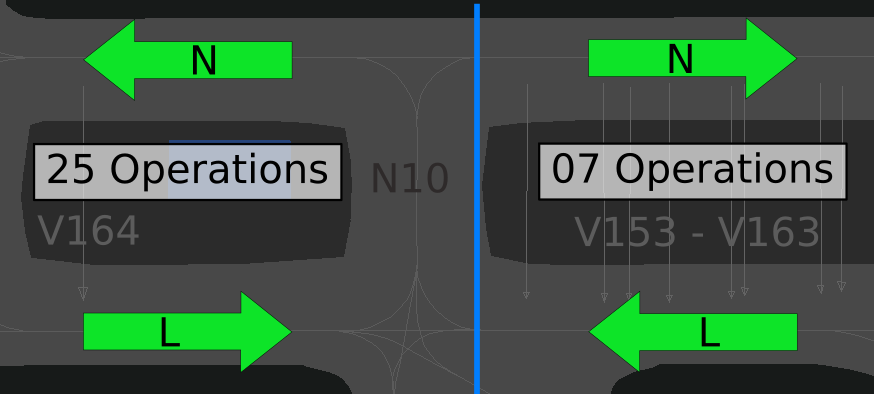](https://knowledgebase.vatsim-germany.org/uploads/images/gallery/2022-07/edff-eddf-n-l.png)*Usage of Taxiways N and L*
#### Taxiway Restrictions
All relevant restrictions can be found in the Euroscope Ground Radar (Functions -> Maps -> Restrictions). For B747, A380, A346 and B77W, charts can also be found [here](https://chartfox.org/EDDF#EDDF_90779). The auto gate assignment will take care of that, so if a stand is auto assigned, the aircraft is allowed to taxi on the taxiway to get there.
#### Taxiway Links
Links connect taxiways N7 and N8 at different locations to enable the best traffic flow. If N7 and N8 are used within the same instruction, **Links 3, 4 or 5** shall be used whenever applicable. These Links should be used with care because some pilots might not find/know them (Links are difficult to find as there are no signs, just visible at the charts). More images are available [here](https://knowledgebase.vatsim-germany.org/books/airports-langen-fir-edgg/page/general "Taxiway Links at Frankfurt Airport").
**Link 1** does not exist in real life anymore, and can not be found on any charts! Link 3 or N8 - N - N7 should be used instead.
[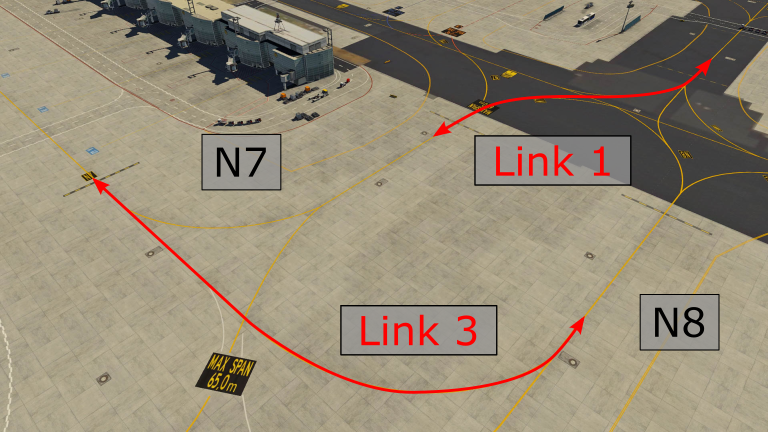](https://knowledgebase.vatsim-germany.org/uploads/images/gallery/2022-07/eddf-link1-link3-outside.png)*Usage of Link 1 and Link 3 between N7 and N8*
#### Colored Lines
Colored lines (orange and blue) can be used by all aircraft up to code C aircraft (A321/B739). Preplanning is required to use them the most efficient way.
[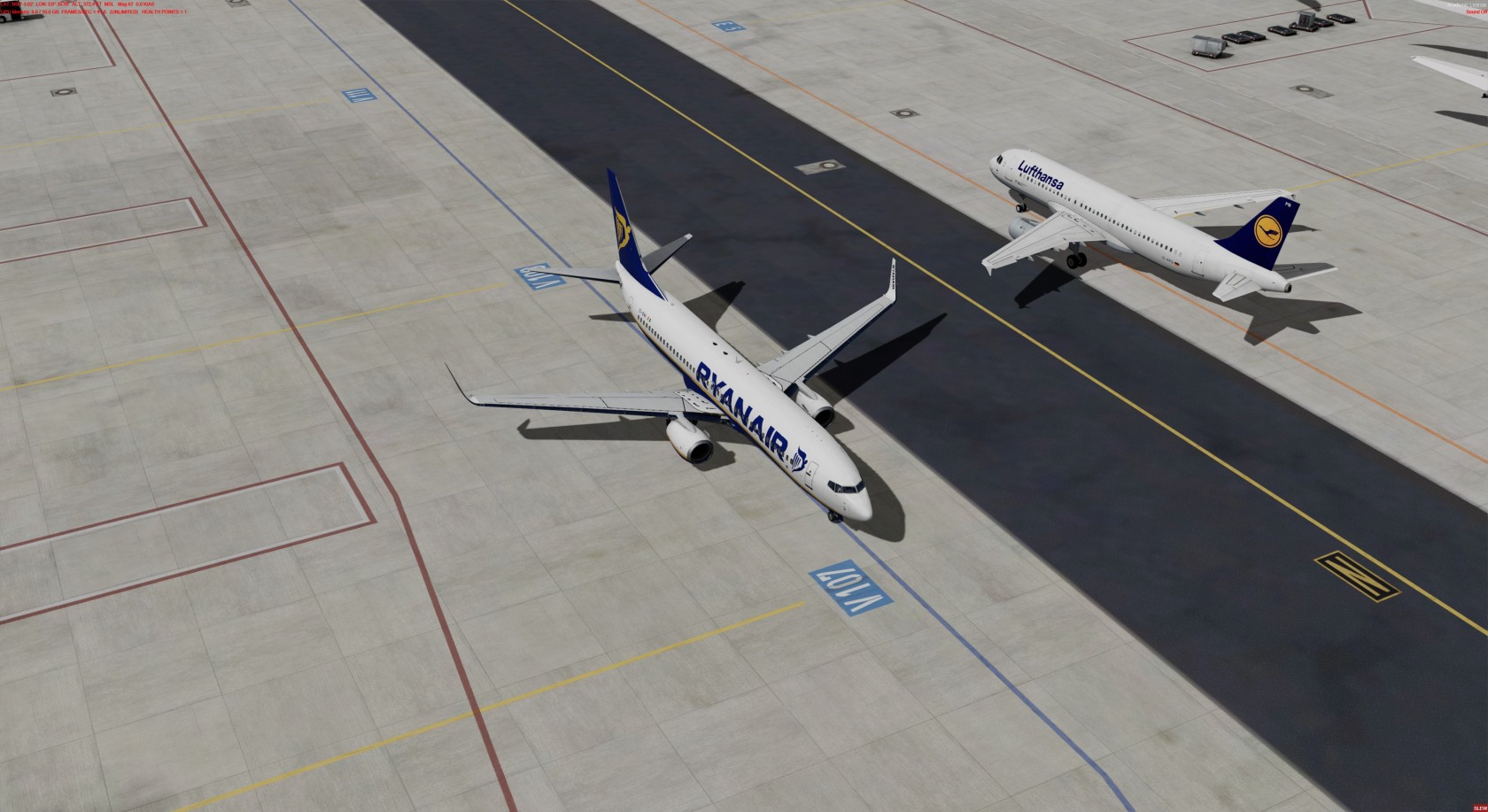](https://knowledgebase.vatsim-germany.org/uploads/images/gallery/2022-07/blueorange.jpg)*N-Blue and N-Orange used at the same time for parallel taxi*
#### Pushback
V134 - V178 (all facing south), as well as positions C2, B10 and A1 are taxi out positions. V143 and V144 are pushback positions! Almost all stands at the new GAT (V702-V721) are pushback positions, only V701 is a taxi out stand.
##### Straight pushbacks
Pushback from positions **V108 - V118** (even numbers) always have to be done straight back. Straight pushback out of **V106** will end behind position V108 facing north, when a GSX profile is used. Otherwise the intersection L/N-East - T is blocked.
> DLH123, pushback approved, straight back, no turn.
[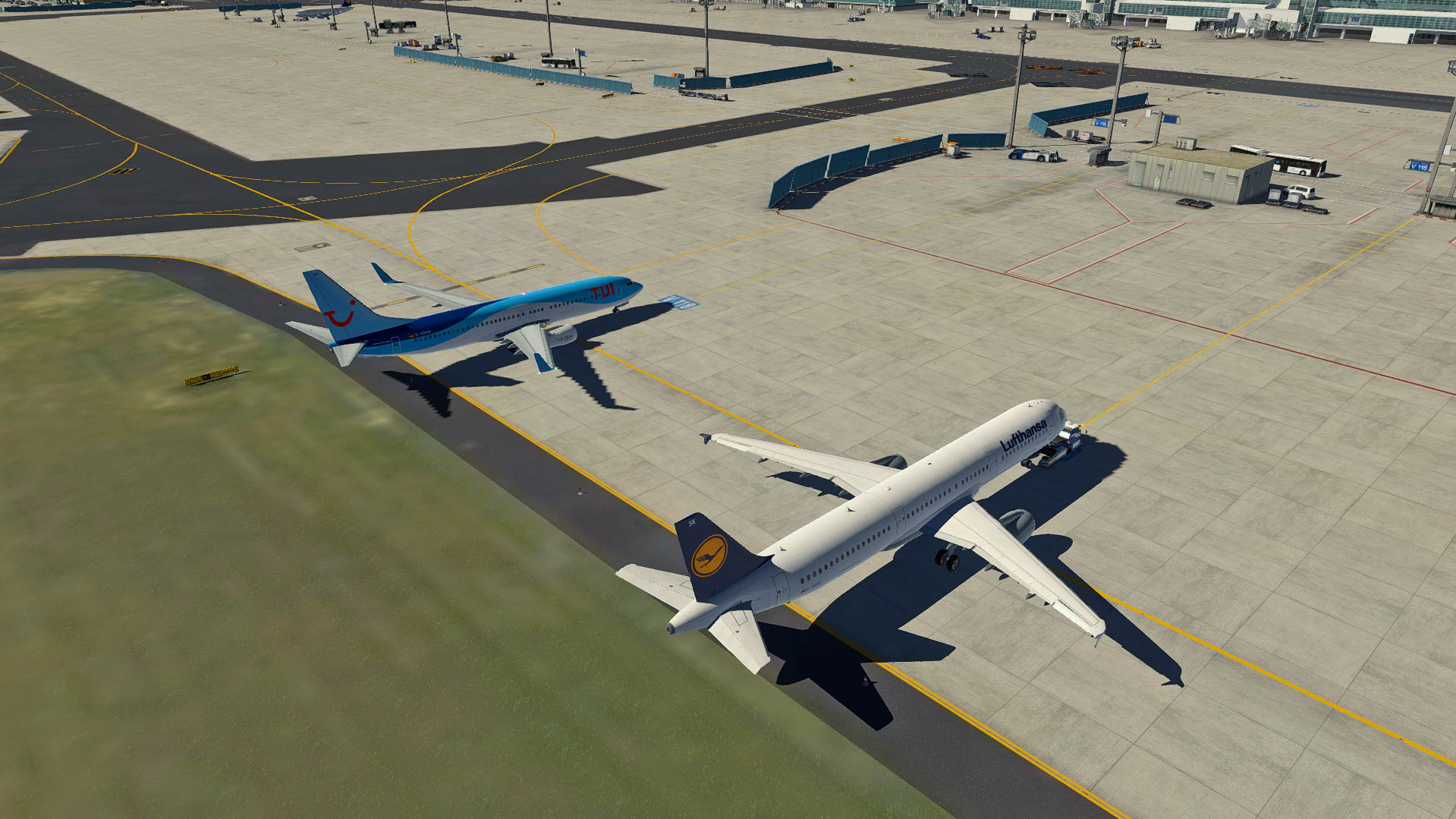](https://knowledgebase.vatsim-germany.org/uploads/images/gallery/2022-07/eddf-straight-push.jpg)*Straight pushback at positions V108 - V118 without turn*
Straight pushback is also possible from positions V266 - V270 instead of using pushback areas 1 and 2.
In the real world, a straight pushback from V270 will result make a slight curve to end up behind stand V269 facing North. Some GSX profiles may simulate this, so controllers should consider V269 blocked until the straight pushback from V270 has concluded.
##### Pushback Areas
Various areas of Frankfurt's apron utilize predefined pushback areas to which pilots can be instructed to push. Depending on the combination of the stand and the pushback area, a push and pull maneuver may be required which not all pilots are able to comply with; if in doubt, controllers should ask the pilot if they are able to conduct a push and pull maneuver. Additionally, some GSX profiles now only offer presets for these areas at appropriate parking positions so pilots may explicitly request an area if they are given a normal pushback; this should be accommodated when possible, but GSX also allows pilots to manually edit their pushback route, so when a normal pushback makes more sense, the pushback to an area can also be denied.
These areas are always only available for the applicable yellow taxiline; when instructing an aircraft to push onto a colored line, areas may not be used.
As charts don't inform pilots of the possible directions for each area, the **direction shall always be given with the clearance when instructing a pilot to push to an area**.
| **Taxiway**
| **Area**
| **Nose gear abeam stand**
| **Facing**
| **Restriction** |
| N
| 2
| E5 / V111
| *West/East*
|
|
| N-East
| 1
| *nose gear abeam service road between V106 and V107*
| North
|
|
| N3
| 1
| C6 / B44
| South
| max. Code C
|
| 2
| C11 / B45
| South
| max. Code E
|
| N5
| 1
| A15 / B22
| South
| max. Code C
|
| 2
| B25 / A21
| South
| max. Code E
|
| 3
| B26 / A25
| South
|
|
| N7/N8
| 1
| A16
| West
| max. Code C
|
| 2
| A24
| South-West
| max. Code E
|
| 3
| A58A
| West
|
|
| 4
| A30
| West
| max. Code C
|
| 5
| A58B
| East
| max. Code E
|
| 6
| A40
| West
| max. Code E
|
| 7
| A66B
| West
|
|
| 9
(should not be used)
| *short of N*
| South
|
|
| P1
| 1
| F238
| *West/East*
|
|
| 2
| V267
| West
|
|
| S4
| 1
| G6
| North
|
|
| 2
| G12
| North
|
|
| S5
| 1
| H4
| North | max. Code C
|
| 3
| G13
| North
|
|
| S7
| 2
| H12
| North
|
|
| S11/S15
| 6
| V326
| North
|
|
| 7
| *short of S*
| North
|
|
| 1
| K4
| West
| max. Code C
|
| 2
| K10
| West
|
|
| 4
| *short of S11*
| West |
|
| L
| 1
| V94
| West
| max. Code C
|
| 2
| V97
| West
| max. Code C
|
##### Other restrictions
Pushbacks from **position F231** are only possible facing East.
Pushbacks from **positions B23, B28, B42 and B48** have to finish the pushback on taxiway N (or in N4). While the pushback is still in progress, the intersection N - N4 can **not** be used!
#### Gate Assignment
Gates will be assigned by Ground Radar Plugin according to the real world. A-Stands are mainly used for DLH, AUA, TAP, AEE, SWR and UAL (Schengen and Non-Schengen area). Gates A50 to Gates A69 are DLH only. B and C-Stands are used for Star Alliance flights outside the Schengen area. Terminal 2 is mostly used for non-Star Alliance members and low cost operators, that are also located at the V-Positions in front of Terminal 2.
The first apron controller the inbound traffic contacts will always tell them their gate, even if it's under another Apron's responsibility.
> **Frankfurt Apron (West)**: DLH1255, gate A25, taxi via N11, L hold short of N8.
>
> **Frankfurt Apron (West)**: DLH1255, contact Apron on 121.855.
#### Inbounds 25C/07C
Inbound traffic from runway 25C/07C will be handed over from Tower with a hold short of L. This traffic is still blocking the runway after vacating and has to be treated with number one priority.
#### Handoff
Handoff to the next Apron controller will always take place with a hold short instruction of the next intersection close to the border of the area of responsibility (e.g. traffic from Center to West at N with a hold short of N10). Do not label any hold short for the transfer that is defined by the SOP!
#### Traffic Flow
If you have any “potential conflict” that will just generate waiting time for the pilot, please try to solve the problem without assigning a new gate. That will improve your preplanning skills a lot. Always try to work with conditional information as precisely as possible, but do not overload the pilot with useless information!
> **Frankfurt Apron**: DLH123 at L give way to opposite company A320.
>
> **Frankfurt Apron**: DLH456 at N4 number two behind Singapore A350 from right.
>
> **Frankfurt Apron**: DLH789 behind opposite British Airways A319 taxi to holding point runway 18 via N, hold short of N5.
##### Tricks
- keep the traffic flow dynamical and use conditional instructions as often as practicable. Resolve a hold short with a conditional instruction as soon as practicable.
- you may deviate from the default taxi flow (coordination might be required) to enable an efficient flow (e.g. via N3, N, N1 instead of L).
- you may have to adjust the routing to avoid conflicts and holdshorts
- you have to monitor taxiway M and the holding points to see what you can expect entering your sector within the next minutes
### Use of Intersections
**Runway 07C/25C:** Apron will not clear outbound traffic into intersections for runway 25C/07C. All outbounds are instructed to hold short of the intersection and Tower will instruct them to join the intersection that might be the best for the departure sequence.
> **Frankfurt Apron**: DLH123, taxi to runway 25C via N4 and L, hold short of L3.
> **Frankfurt Apron (Center)**: DLH505, taxi to runway 25C via N8 and L, hold short of N4.
>
> **Frankfurt Apron (Center)**: DLH505, contact Apron on 121.955.
>
> **Frankfurt Apron (East)**: DLH505, hallo, continue via L, hold short of L3.
>
> **Frankfurt Apron (East)**: DLH505, contact Tower on 118.780.
> **Frankfurt Apron**: AAL71, taxi to runway 25C via N, N1, hold short of L.
>
> **Frankfurt Apron**: BAW906U, taxi to runway 18 via orange line and N, hold short of N5.
It is important that every handoff takes place as early as possible and has to be free of conflicts. Every potential conflict needs to be solved prior to the handoff. As soon as the outbound traffic is in contact with Tower, it is released by Apron up to L1 and Tower has the possibility to use every further intersection available. Even if the pilot reported to Apron to be able for L6, Tower still can use L3 (or L1) intersection if there is no benefit for the outbound to use an intersection. In that situation with traffic on L under control of Tower, other outbound traffic e.g. joining L via N3 needs to be number 2 behind the traffic on L.
Intersections a pilot is able for should be noted in the remarks. Do not label any hold short for the transfer that is defined by the SOP!
Keep in mind that if you would like to solve a conflict it might be useful to let outbound traffic continue via L even if he would be able for L6.
**Runway 18:** Departures out of runway 18 will always be sent directly to the holding point via N/L. Handoff should take place early, so that Tower still has the chance to take outbounds via N-South. During 25 operations intersection L needs to be coordinated. During 07 Operations N is still preferred for all heavy aircraft (routing via L, N14, N).
During high traffic load (decision rests with apron control) All MEDIUM and LIGHT aircraft departing via runway 18 and parking east of taxiway N3 shall be asked if they are able for departure out of intersection S. If they are, they should taxi to hold short of U2. Frankfurt Ground is responsible for further taxi (see "Transition 1" below).
> **Frankfurt Apron**: DLH123A, advise able to depart from runway 18 intersection S?
### Transition 1
Outbounds via runway 18 intersection S will taxi via the southside of the airport and are transferred from Apron to Ground (if staffed, otherwise Center Tower) short of stopbar U2. Further taxi will be issued via U - S - S11 - R - S28 - S. Explicit crossing of stopbars U2 and U6 is required. This is a standard taxi routing called "Transition 1". It can only be found in the AIP EDDF, there are no markings on the taxiways.
> **Frankfurt Ground:** DLH123A, cross U2 and U6, taxi via transition 1 to holding point S runway 18.
If the pilot seems to be unfamiliar with Transition 1, issue the taxiways as usual. Depending on the inbound traffic for runway 25L/07R (there should be no opposite during taxi) further taxi via M can be used to save time.
### Runway Crossing
The taxiways used for crossing are based on the planned parking position and runway in use (see image below). These taxiways are mandatory and only if a pilot uses the wrong taxiway the Tower controller should deviate from that after coordination with Apron. It is also possible to coordinate a different crossing taxiway (M6, M10, M30, Y, T) or procedure between Tower and Apron for crossing.
**LVO:** During LVO inbound traffic landed on runway 25L/07R will not cross the center runway. All traffic needs to taxi via T or Y, depending on their planned stand.
Tower is not allowed to issue take-off clearances as long as the intersection is blocked by just crossed traffic. That’s why **Tower will issue the initial taxi route after crossing** to the Pilot. This depends on the runway in use and the intersection used (see images).
When traffic crossed the runway it shall be sent to the according apron control as soon as possible, so traffic does not need to stop.
Apron is responsible for separation in the Apron at all times. Tower can issue the crossing clearances without looking at potential conflicts. A lot of planning is required for that.
[](https://knowledgebase.vatsim-germany.org/uploads/images/gallery/2023-07/crossing-07.jpg)
| **Entry** | **Stand** | **Hold short of** |
| **P** | all except those via P1 | N11 |
| **P1** | F231 - F238 and V266 - V270 | W |
| **S4 - S23** | South Parking (S, V3xx, J, K, G) | S4 - S23, according to the stand |
### Stopbars
Stopbars U2 - U8, T2 - T8, Y2 - Y12 and S40 close to the extended centerline are used to avoid conflicts between taxiing and arriving / departing aircraft. They can be seen on the Airport Chart and on the Euroscope Radar. Taxiway U should be used southbound and Taxiway T should be used northbound.
**Stopbars at T and U:** There must not be any traffic between T2 and T4 (RWY 25C) or T6 and T8 (RWY 25L) when there is landing traffic vertically above TWY T or departures out of 07C/07R still below 500ft AGL. The same applies for U2/U4/U6/U8.
However, there is one exception for U: Taxiing traffic with a tail height **not greater than 11,81 m** (all light and medium aircraft except A318 and B737 NG/MAX) may cross all stopbars at U **independenly from arrivals if they are on a precision approach** (ILS / GLS). This helps especially for traffic on Transition 1 (see above)
As a rule of thumb, the crossing clearance at a stopbar for may be given when the inbound is on minimum 4 NM final.
[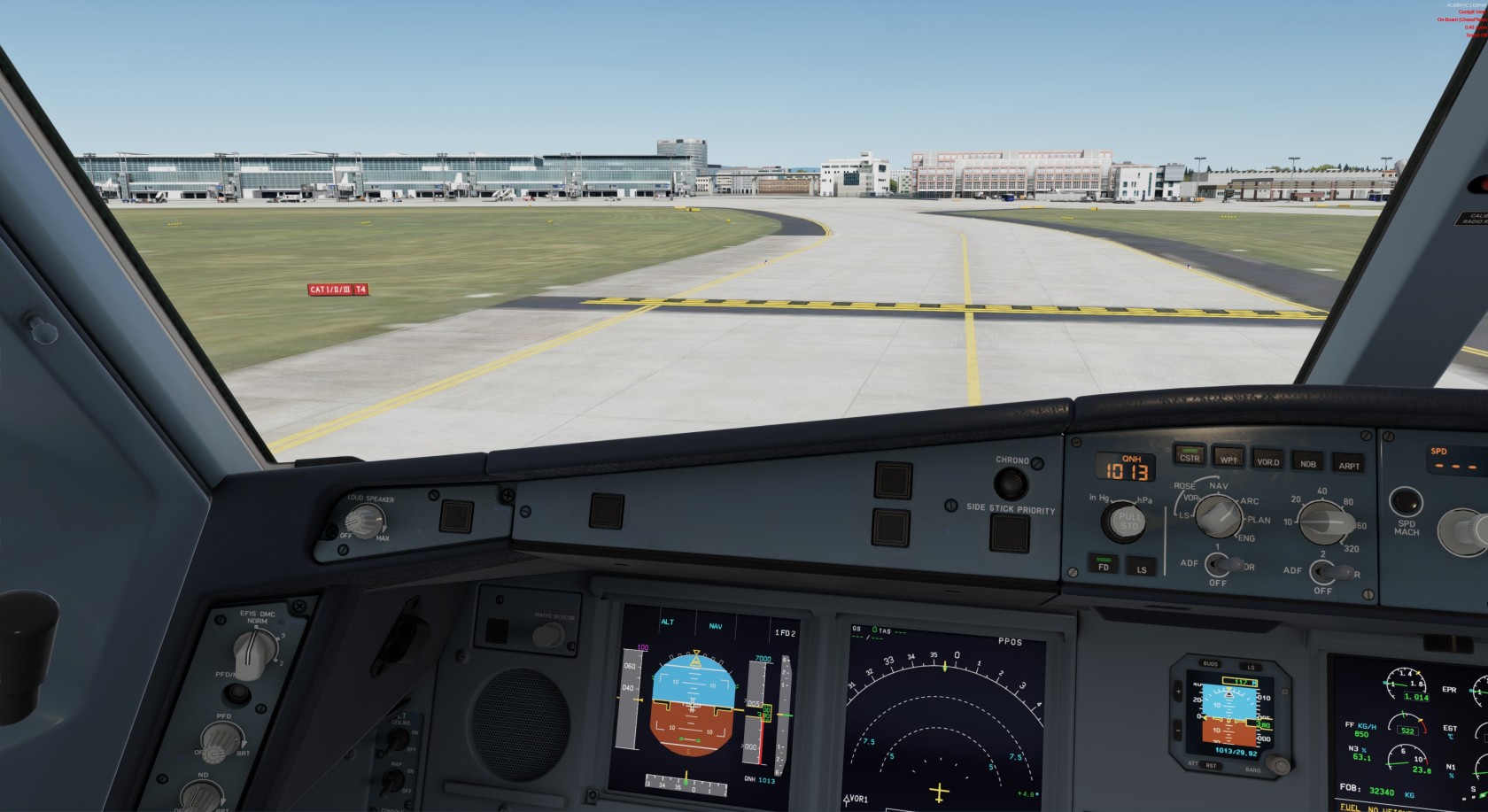](https://knowledgebase.vatsim-germany.org/uploads/images/gallery/2022-07/eddf-t4.jpeg)*Inbounds have to hold short of stopbar T4 (yellow lines on the ground).*
*Name of the stopbar at the red sign on the left.*
**Stopbars at Y:** There must not be any traffic between Y4/Y10 and Y2 (RWY 07C) or Y6/Y12 and S40 (RWY 07R), when there is landing traffic vertically above TWY Y or outbounds runway 25C/25L still below 500ft AGL.
### Specialties during 07 Operations
**Border at N5:** Traffic from Center to East Apron needs to hold short of N5. As soon as the handoff is initiated, this traffic is released and will always be number one (green aircraft). Only hand off aircraft which you do not need to stay there (e.g. if you would like to have your outbound at N5 as number 1 - see image, THY25L).
[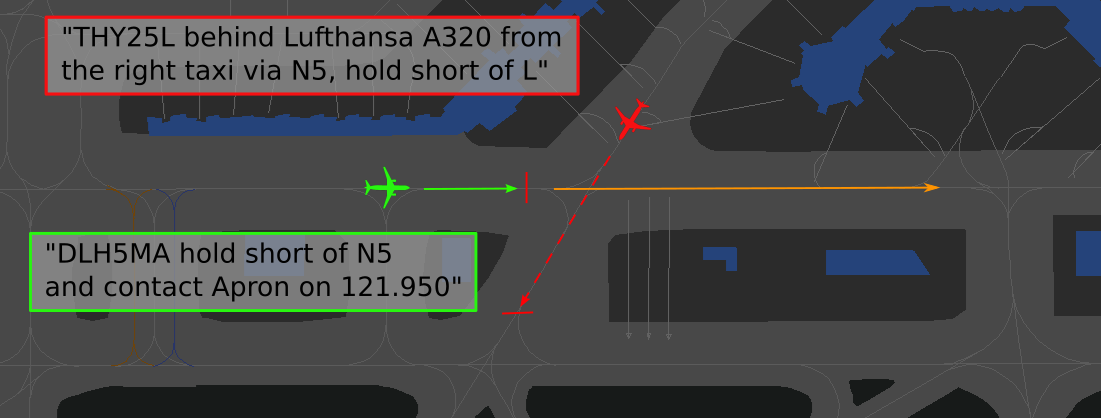](https://knowledgebase.vatsim-germany.org/uploads/images/gallery/2022-09/eddf-n5-07.png)
| **Station** | **Station ID** | **Login** | **Frequency** | **Remark** |
| **Center Tower** | DFTC | EDDF\_C\_TWR | 118.780 | **primary station** |
| **West Tower** | DFTW | EDDF\_W\_TWR | 124.855 | **secondary station** |
| **North Tower** | DFTN | EDDF\_N\_TWR | 136.500 | will be taken over by DFTW if not staffed |
| **South Tower** | DFTS | EDDF\_S\_TWR | 119.905 | will be taken over by DFTC if not staffed |
| **Ground** | DFG | EDDF\_GND | 121.805 | will be taken over by DFTS if not staffed |
Ground can also be taken over by West Tower after coordination. However, it cannot be taken over by any Apron station.
If multiple Tower stations are staffed, the responsibility for VFR traffic within the control zone can be coordinated for every single VFR flight or in general. Without coordination, South Tower is responsible for all VFR traffic (inbound VFR traffic from the North will initially call North Tower).
### Runway Usage
Frankfurt Tower is responsible for the direction of operations. 25 operation is preferred up to a tailwind component of 5 kts. Runway 18 is always used up to a tailwind component of 15 knots.
If the [tailwind component](https://sim.tools/ "sim.tools") of runway 18 is greater than 10 knots, this should be broadcasted via ATIS. Then pilots need to report if unable to accept runway 18 on initial call. It might be more efficient to close runway 18 depending on the amount of pilots that report being unable due to the required separation (see separation below).
**Approaches:** By default, the ILS Approach is used for all arrivals, except coordinated otherwise. For runway 25R/07L ILS Y is preferred without tailwind and during CAT I operations.
Inbounds for the GAT and the south apron should be instructed to vacate runway 25L/07R to the south.
### Separation and Transfer of Communication
#### Departing Traffic
All departures must be separated by at least **3 NM or wake turbulence separation**, whichever is greater. Tower has to ensure initial separation between departures and between departures and missed approaches.
To increase runway capacity, visual separation between departures [according to this article](https://knowledgebase.vatsim-germany.org/books/separation/page/visual-separation "Visual separation") is permitted with the following restrictions:
- Only during VMC and no ceiling (no BKN / OVC clouds)
- Only when wake turbulence separation is not applicable
- (Reduced) Runway separation must be ensured
- Traffic information shall be given to the suceeding departing aircraft
- The procedure shall only be applied for aircraft on immediately diverging SIDs (25: between M/H/W/K departures and F/G departures to the north, 07: between D and E departures, 18: between S and L/U departures)
- Handover of the suceeding traffic shall take place earliest when 3 NM or 1000 feet are ensured between the departures
- The departure controller shall be informed about this procedure
**Departures with the same SID** need to be separated by at least 5 NM at transfer of communication.
**Rule of Thumb for aircraft with same performance:**
A separation of 3 NM can be achieved when the succeeding traffic receives its takeoff clearance as soon as the preceeding traffic is overflying the end of the departure runway. For a separation of 5 NM the proceeding traffic needs to be 2 NM away from the end of the departure runway.
**Same SID, different runways:** Especially between southern departures out of runways 07/25 and 18, Tower has to pay special attention to initial separation.
All departing aircraft out of Frankfurt must be instructed to contact the appropriate Langen Radar frequency after departure. This instruction shall be given when the aircraft is airborne and free of conflict with other departures and / or missed approaches. The transfer should be initiated early enough to avoid the flight leveling off (at +/- 1000 ft AMSL).
As the approach / departure controller shall always cross-couple both real-life departure frequencies, the departure frequency will always be 120.155 for departures towards MARUN, TOBAK, OBOKA and 136.130 for departures towards SULUS, KOMIB, CINDY, ANEKI, SOBRA and ULKIG - regardless of the departure runway / SID.
#### Arriving Traffic
For inbounds, Frankfurt Arrival is responsible for separation until transfer of communication. Frankfurt Tower is responsible for maintaining separation of arriving traffic from transfer of communication until touchdown, if necessary by use of adequate means (e.g. speed control), and during the initial part of a missed approach.
The minimum separation between two aircraft approaching the same runway is **3 NM or wake turbulence separation**, whichever is higher.
However, under certrain circumstances, the radar separation can be reduced to **2.5 NM** according to NfL I-55/11:
- Both aircraft are within a 10 NM final
- Wake turbulence separation is not applicable
- The exit taxiways of the runway can be observed from the control tower visually or by means of surface movement radar (always applicable at VATSIM)
- The runway is dry
The reduced radar separation minimum may also be applied between alternating approaches to the parallel runways (see below). In these cases, neither the line of sight of the exit taxiways nor the runway conditions need to be considered as a precondition.
**Modes of Operation:** Langen Radar has to coordinate with tower whether parallel independent, dependent or alternating (former staggered) mode will be used. The minimum separation between an aircraft on final runway 25L/07R and another aircraft on final runway 25R/07L is measured diagonal head to head.
| **Mode**
| **Minimum separation 25L/07R - 25R/07L**
|
| alternating
| 2.5 NM
|
| dependent
| 1.5 NM
|
| parallel independent
| independent
|
The default mode with only one arrival / feeder controller is **dependent**. Only when two feeders are in use, **independent** operations are possible. Aircraft performing non-precision approaches (RNP, swingovers) are not allowed for dependent and independent operations.
For different seperation examples check the images below.
Separation Examples
| [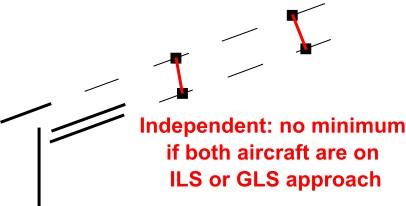](https://knowledgebase.vatsim-germany.org/uploads/images/gallery/2024-10/eddf-seperation-independant.jpg)
| [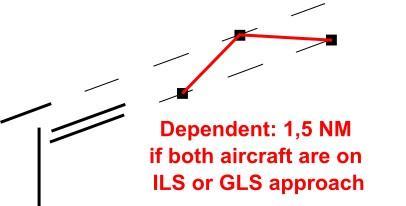](https://knowledgebase.vatsim-germany.org/uploads/images/gallery/2025-04/eddf-seperation-dependant.jpg)
|
| [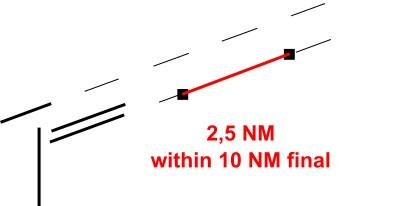](https://knowledgebase.vatsim-germany.org/uploads/images/gallery/2024-10/eddf-seperation-same-rwy.jpg) | [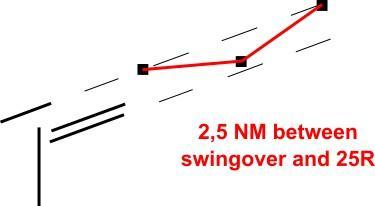](https://knowledgebase.vatsim-germany.org/uploads/images/gallery/2025-04/eddf-separation-swing.jpg) |
| **Runway** | **preceding CAT 1/CAT 2**
**succeeding CAT 1**
| **preceding CAT 1/CAT 2**
**succeeding CAT 2**
| **preceding CAT 3**
**succeeding CAT 1/CAT 2/CAT 3**
|
| **07L/25R** | 600m | 1500m | 2400m |
| **07C/25C** | 600m | 1500m | 2400m |
| **07R/25L** | 600m | 1500m | 2400m |
| **18** | N/A | N/A | 2400m |
### Runway Dependencies
The parallel runway systems 25L/25C and 07C/07R cannot be used for (in)dependent parallel approaches or independent parallel departuers. Instead, radar separation or wake turbulence separation must be applied for departures and arrivals.
However, during approaches on the southern or the center runway, the other runway may be used for departures simultaneously (taboo zones for runway 25 have to be considered though, see below).
#### 25 Operations
**M/H-Departure and departures to the south (e.g. CINDY#F):** Takeoff clearances for runway 25C/25L can be issued when the following conditions are met:
- **Inbound Traffic:** For departures out of runway 25C, the takeoff roll may only start when there is no inbound for runway 25L between 4 NM final and the threshold. For inbounds and outbounds on the same runway, only runway separation has to be applied.
- 25R missed approaches are completely independent to 25C departures with initial turn to the south
- **Outbound Traffic:** Takeoff clearance may be given once the departure on runway 18 has started its takeoff roll
**F/G-Departure to the north:** Takeoff clearances for runway 25C/25L can be issued when the following conditions are met.
- The takeoff roll may only start when there is no inbound for runway 25R between 4 and 0,5 NM final
- (Independent to arrivals on runway 25L)
- (25C: Independent to departures from runway 18)
- Departures out of runway 25L need a release by DFTW. The release can be given once the departure from runway 18 is rolling
- During LVO both tabu zones for 25L and 25R need to be clear of traffic when starting the takeoff roll. Since this is almost impossible during high inbound traffic, all departures should receive the M/H SIDs during LVO so that only one taboo zone has to be considered.
**18 Departures:** Outbounds from runway 25C/25L with initial turn to the south need to reach 2000ft AMSL before the takeoff clearance can be issued. Outbounds from runway 25C directly to the north are completely independent to all 18 departures.
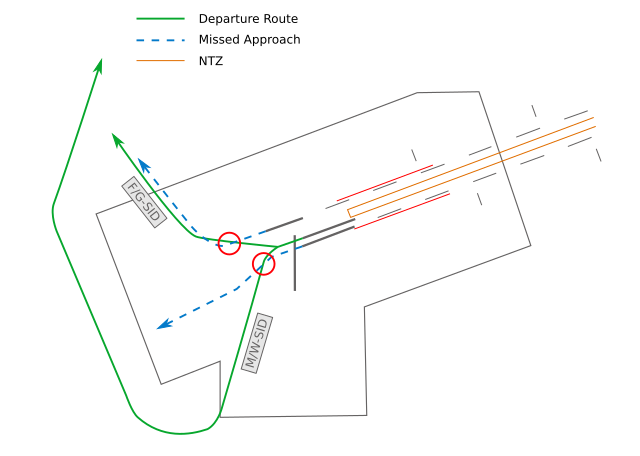*dependencies during 25 operations*
**Missed Approaches:** Missed approaches from runway 25C and 25L are dependent to runway 18 departures. The takeoff clearance on runway 18 can be given, as soon as separation is ensured. Exception: Departures from intersection S are independent to missed approaches. However, a traffic information could increase the situational awareness of the pilot.
**Staffing with multiple tower:** If more than one Tower position is staffed, DFTW is responsible for the coordination between departures runway 18 and 25C/25L. DFTC/DFTS always needs a release by DFTW for all departures with initial turn to the south (M / W / H / K / N / F-SIDs to the south), if not coordinated otherwise. E.g. the phrases "Released" / "DLH123 released" / "MARUN released" may be used.
#### 07 Operations
**Outbounds 07:** All outbounds out of runway 07C are independent to all arrivals on runway 07R and departures on runway 18.
In case of a go around on runway 07R, Tower has to ensure separation. In case of a southbound departure from RWY 07C, the missed approach should be turned to the south above the MVA and the departure should stay on runway track.
Missed approaches on RWY 07L and OBOKA/MARUN#E departures are **not** separated procedural. In case of go around on runway 07L, Tower has to ensure separation with departures out of runway 07C.
**18 departures:** Departing aircraft on runway 18 from N / N-South / L have to start their takeoff roll before any aircraft on final runway 07R is between 4 NM final and runway 18. Also, traffic departing from these intersections need to be separated by time-based wake turbulence behind arrivals on runway 07R (see table below).
For departures out of **intersection M** it must only be ensured that the inbound will not overfly the departing traffic on runway 18, so the 4 NM restriction does not need to be taken into account as well as wake turbulence separation. Departing traffic out of full length can taxi down the runway to intersection M (not via taxiway Y) to improve the departure sequence.
> DLH123, lineup runway 18, on the runway taxi down to intersection M.
Outbounds via **intersection S** are completely independent to arrivals for runways 07C and 07R.
##### Time-based wake turbulence separation 18 Outbound vs. 07R Inbound
| **Preceding** | **Succeeding** | **Separation** |
| Medium | Light | 2 min |
| Heavy
| Light | 2 min |
| Medium | 2 min |
| Super
| Light | 3 min |
| Medium | 3 min |
| Heavy | 2 min |
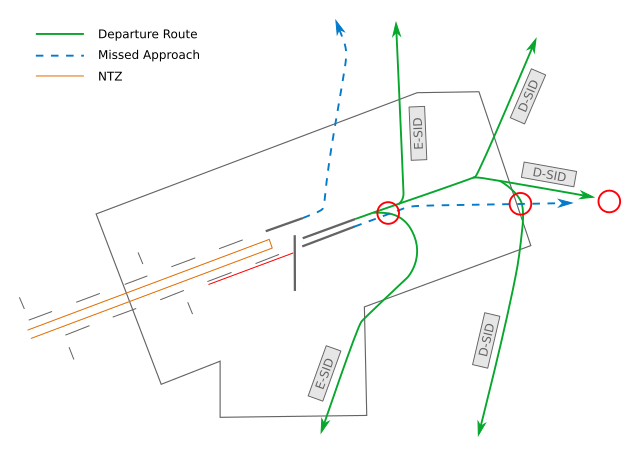*dependencies during 07 operations*
#### Spacing on Final
Due to the taboo zones, it might be necessary to coordinate a target spacing on final to get departures out, especially during an inbound rush. This can be done either individually for each departure (good preplanning is necessary - when the final is full, the next gap might take around 6 minutes) or by using a general spacing on final.
Recommended spacing values are:
- **07R arrivals:** 5 NM (minimum 4 NM at touchdown)
- **07L arrivals:** Radar Separation
- **25L arrivals:** 6 NM (minimum 5 NM at touchdown)
- **25R arrivals:** 5 NM (minimum 4 NM at touchdown)
### VFR Traffic
D-CTR of Frankfurt reaches up to 2500ft AMSL. For details see VFR charts.
**Runway used:** VFR Traffic should use runway 25L/07R for arrival, outbounds can depart from any runway (except 25R/07L) depending on the traffic situation and the intentions of the VFR traffic. VFR departures out of runway 25L/25C can be instructed not to overfly runway 18. Nevertheless, it is necessary to wait with an 18-takeoff clearance until the VFR departure turns away from runway 18. Low approaches / Touch and go's can only be performed on the center or southern runway, whatever facilitates the traffic flow. The northern runway is not allowed for VFR approaches due to noise abatement. However, the downwind of this runway can of course be used.
There are VFR holdings in the control zone north and south of the airport. Traffic in these holdings shall be instructed to stay clear of runway 18 or final runway 25R.
**VFR Squawk:** All VFR traffic inside the controlzone of Frankfurt will get the transpondercode 4447. Police (POL - 0036) and Christoph rescue helicopter (CHX - 4444) will remain their squawk.
**Helicopter Operation:** All helicopters always have to land or depart at an active runway at Frankfurt airport. Thereafter they need to air-taxi to their destination at the airport (usually a stand at the GAT or next to the accident side).
**Important Landmarks for VFR Flights**
- River Main
- Downtown Frankfurt (Northeast of the CTR)
- BAB 3 (west to east through the CTR)
- BAB 5 (north to south through the CTR)
- BAB 60 (Splitting of BAB 67 to the west)
- BAB 67 (north to the southwest of RWY 18)
- Frankfurt Uniklinik (Northeast of the CTR)
[VFR Charts - Openflightmaps](https://www.openflightmaps.org/ed-germany/)
**Wiesbaden corner:** To facilitate traffic circuit operations at Wiesbaden airbase (ETOU), the Northwestern corner of the Frankfurt CTR can be delegated to Wiesbaden Tower up to 1500ft. In addition, controllers shall be aware that in addition to the traffic circuits, Wiesbaden VFR routes Echo and Apache also cross the Frankfurt CTR along Autobahn 66.
Wiesbaden corner
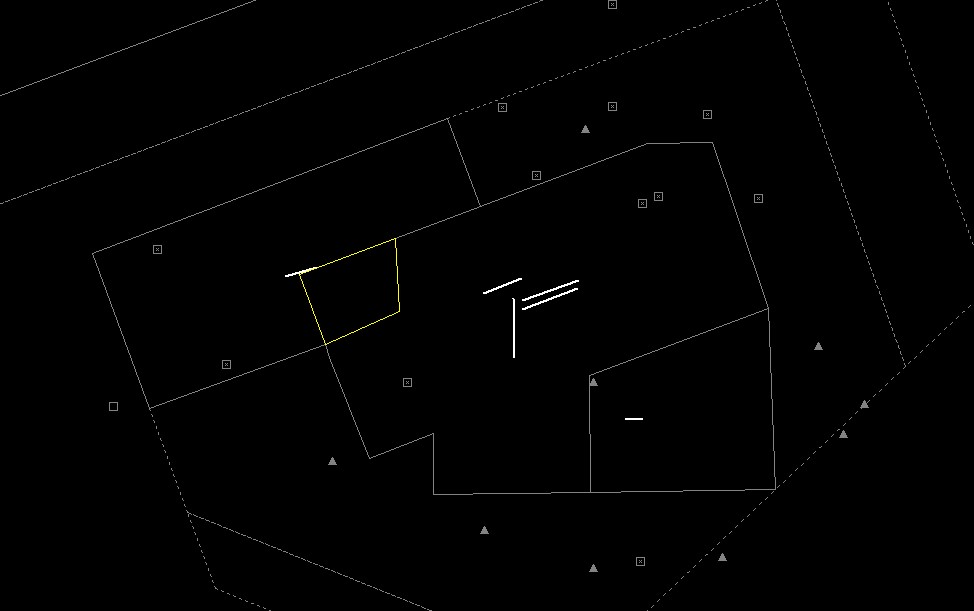
The Wiesbaden corner will automatically be displayed when Wiesbaden Tower is staffed, but can also be manually displayed via the TopSky maps, e.g. if there is circuit traffic at Wiesbaden while DFAN covers the airport topdown.
Tower will get Outbounds for runway 07C/25C short of the intersections. The intersection to use can be decided by Tower depending on the best departure sequence. Therefore only L1, L3, L4, L5, L6 and L9 can be used during 25 operations and L14, L16, L17, L19, L20, L21 for 07 operations. Tower needs to instruct the pilot to join the intersection.
Usage of Intersections
Only intersections with a published TORA (see charts) may be used for departures, even if the pilot reports that he would be able for a different intersection. As an exception, helicopters may depart from every part of the runway up to the runway end.
Generally, an intersection may only be assigned to a departing aircraft when the pilot either reports by himself that he is able for that intersection or agrees to it after a controller’s request - regardless of the aircraft type.
In theory, every pilot has to report the earliest possible takeoff intersection to the tower controller according to the AIP EDDF. This is often not done in practice though, therefore the tower controller still needs to ask if the pilot is able to use an intersection. Exemptions of this rule are intersections L and M of runway 18 during 07 operations. The ATIS states that these are to be expected for every aircraft and pilots have to report if they are unable for M.
Also, it is common practice to assign the following intersections without prior agreement since they only differ by a few meters from full runway length: L3 (25C), L20 (07C), N-South / L / W3 (18 - only applies for Mediums, Heavies have to be asked).
To protect the center runway, all traffic holding short **can** be instructed to stop at the CAT II/III holding point (real procedure)! As many pilots are confused by this instruction, a "normal" hold short of the runway can be used instead.
> **Frankfurt Tower**: DLH123A, taxi via M and M8, hold at CAT II holding point runway 25C.
> or
> **Frankfurt Tower**: DLH123A, taxi via M and M8, hold short of runway 25C.
During 07 Operations inbounds landed on runway 07L with parking position west of N11 should be transferred directly to West Apron.


Inbound traffic entering the Apron without crossing the runway will be instructed according to the table below. Frankfurt Apron is always responsible for all GAT and movements at the southern apron!
| **Entry** | **Stand** | **Hold short of** |
| P | all except those via P1 | N11 |
| P1 | F231 - F238 and V266 - V270 | W |
| S4 - S23 | South Parking (S, V3xx, J, K, G) | S4 - S23, according to the stand |
Do not label hold shorts that are defined by the SOP!
### Visual Swingovers
Inbounds for runway 25L have the possibility to do a visual swingover (visual approach) to runway 25C when reaching the 7 NM final (2500ft MSL). Therefore the pilot has to have the runway in sight. During 07 operations a swingover is only available for safety reasons or to avoid a missed approach.
**Dependencies:** Visual swingovers must be separated by at least 2.5 NM to approaches on runway 25R/07L. They do not have to be coordinated with Langen Radar as long as separation to other aircraft is obviously great enough. If the 2.5 NM cannot be maintained, the procedure can still be applied if the **succeeding** aircraft confirms the parallel traffic in sight and maintaining visual separation.
**Missed Approach:** With the clearance for the visual approach the pilot has to be given a new instruction how to continue in case of a missed approach. Therefore runway track and a climb to 5000ft shall be used.
> **Frankfurt Tower**: DLH123, advise able for visual approach runway 25C and parallel A320 2 o'clock in sight?
>
> **Pilot**: Able and in sight, DLH123.
>
> **Frankfurt Tower**: DLH123, maintain own separation, cleared visual approach runway 25C, (do not overshoot to the north). In case of missed approach climb straight ahead 5000ft (and contact Frankfurt Tower 118.780).
A swingover can have several benefits. The taboo zone can be avoided (see below) or safety reasons e.g. to avoid missed approaches. Pilots are often happy about reduced taxi times on ground.
**Swing to depart**: A swingover can also be used to improve the outbound flow for runway 25C with M/W departures, as there is no 4 NM no-fly zone that need to be taken into account. A takeoff clearance on runway 25C can also be issued if the inbound is closer than 4 NM, which would not be possible if this traffic was approaching runway 25L.
The inbound will be handed over to the according apron, with a hold short of L, as soon as possible.
> **Frankfurt Tower**: DLH123, vacate to the right, hold short of L and contact Frankfurt Apron 121.855.
### Low Visibility Operations
LVO become effective once the **ceiling / vertical visiblilty is below 200ft or the vertical visibility cannot be detected or any RVR in the METAR is equal or below 600m.**
During LVO, the following procedures shall be applied:
- LVO shall be **announced** in the **ATIS** (Code "&lvp")
- Only the **Z ILS** for the northwestern RWY may be used
- All traffic shall be told to **hold at the CAT III holding points**
- The **RVR value for the corresponding runway** shall be given with the **landing clearance** and in the case of guided take-off (RVR ≤ 125m) with the take-off clearance
- **25 Departures** should only depart from RWY 25C via **M/W SIDs** (reason: F/G Departures and a missed approach on runway 25L would mean a loss of separation during bad weather, but M/W SIDs are independent to published missed approaches from runway 25R)
- **Runway crossings are not allowed**
- During RWY 25, landing traffic that would cross via M8 shall taxi via T and traffic that would cross via M30 shall taxi via Y
- During RWY 07, all landing traffic shall taxi via T
- Optional procedures for advanced controllers: Consideration of sensitive and critical areas of the ILS
- The sensitive and critical areas for every runway and aircraft category can be displayed in Euroscope via Functions -> Maps -> LVP
- [](https://knowledgebase.vatsim-germany.org/uploads/images/gallery/2024-11/screenshot-20.png) Yellow areas show the sensitive areas
- [](https://knowledgebase.vatsim-germany.org/uploads/images/gallery/2024-11/screenshot-22.png) Orange areas show the sensitive areas for non-orthogonal and non-parallel traffic
- [](https://knowledgebase.vatsim-germany.org/uploads/images/gallery/2024-11/screenshot-21.png) Red areas show the critical areas
- The wake turbulence category always refers to the preceeding aircraft on the runway, not the suceeding on final
- For Light and Medium aircraft, there are no restrictions except that they must be clear of the CAT III holding point before the next inbound is over the runway threshold
- For Heavy / A388 aircraft:
- Sensitive areas must be clear as soon as the next inbound is within 2 NM final
- As a rule, sensitive areas are always clear when the aircraft has passed the CAT III holding point
- Critical areas must be clear as soon as the next inbound is within 4 NM final
- When applying these advanced procedures, the following spacing should be the coordinated with APP for arriving flights:
- 5 NM behind Light / Medium aircraft
- 7 NM behind Heavy / A388 aircraft
# EDDF - Arrival/Departure
Arrival can be split in 6 stations as shown in the table below.
| **Sector** | **Station ID** | **Login** | **Frequency** | **Remark** |
| **Pickup
|
| **Arrival North** | DFAN | EDDF\_N\_APP | 120.805 | primary
|
| **Arrival South** | DFAS | EDDF\_S\_APP | 125.355 | --
|
| **Feeder
|
| **Director North** | DFFN | EDDF\_H\_APP | 127.280 | secondary
|
| **Director South** | DFFS | EDDF\_L\_APP | 118.505 | --
|
| **Departure** |
| **Departure North** | DFDN | EDDF\_N\_DEP | 120.155 | --
|
| **Departure South** | DFDS | EDDF\_S\_DEP | 136.130 | --
|
All APP/DEP frequencies shall always be cross-coupled by the responsible controller.
### Terminal Maneuvering Area (TMA)
Below you can find the arrival sector of Frankfurt with its subsectors. In case there is only one controller online, the whole sector is controlled by them. All subsectors combined constitute the Terminal Maneuvering Area (TMA). The MVA chart is available via [chartforx.org](https://chartfox.org/eddf "chartfox.org") or as Topsky Map at Euroscope. The airspace structure can be found at [openflightmaps.org](https://www.openflightmaps.org/ "openflightmaps.org").
| [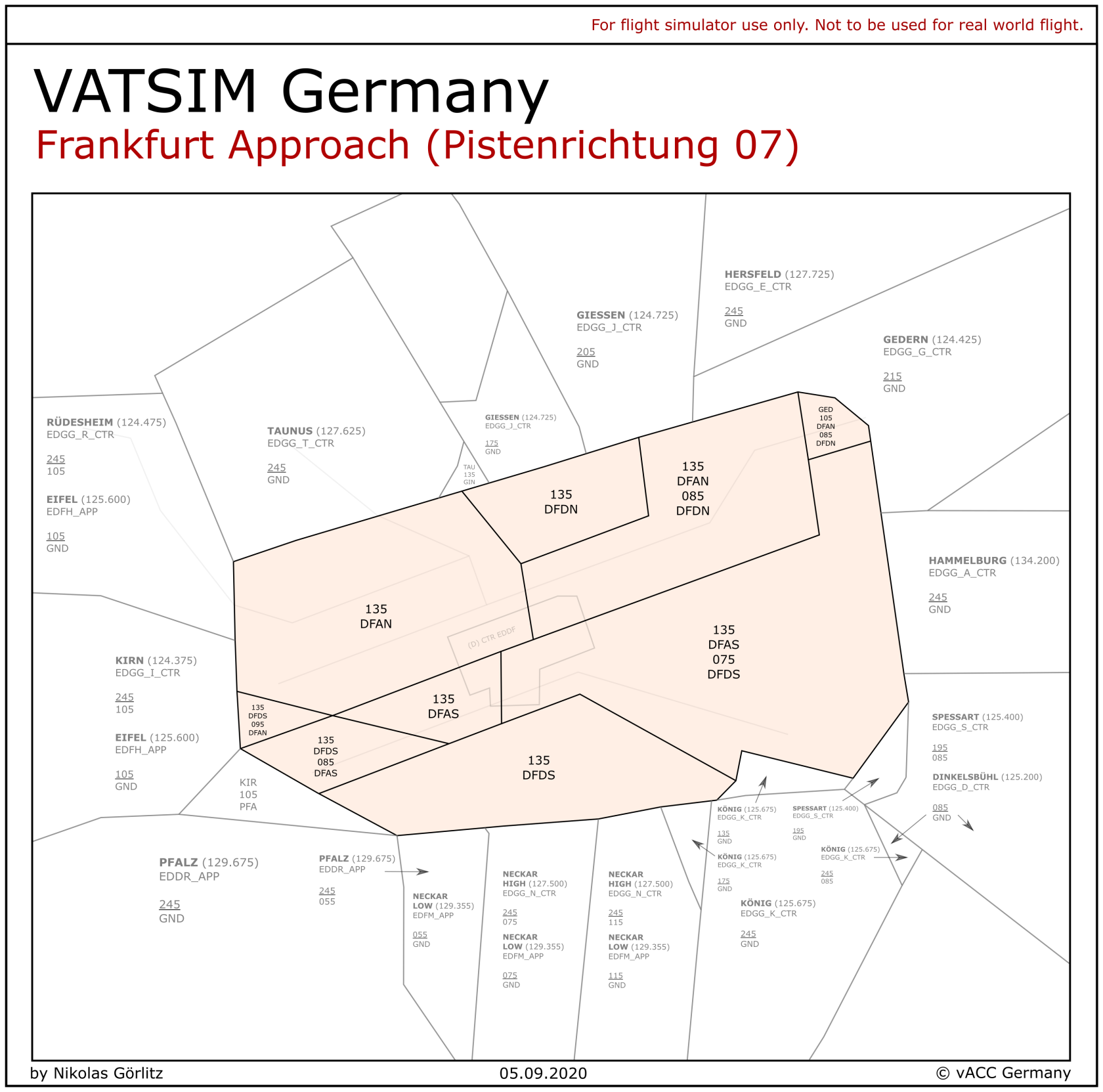](https://knowledgebase.vatsim-germany.org/uploads/images/gallery/2022-11/frankfurt-approach-sectors-07-config.png) | [](https://knowledgebase.vatsim-germany.org/uploads/images/gallery/2022-11/frankfurt-approach-sectors-25-config.png) |
**Departure:** If only one Departure controller is online, he takes over the other Departure sector. If no Departure controller is online, Arrival North takes over Departure North and Arrival South takes over Departure South. If only one Arrival controller is online, he takes over the other Arrival sector.
**Director (Feeder):** Feeders do not have their own sectors. They are assistants of the Arrival controllers which is why Director North has the same sector as Arrival North and Director South has the same sector as Arrival South. If only one Director is online, he is the Director for both Arrival controllers.
### Arrival Procedures
#### General Procedures
**Arrival Routes:** As the clearance limits for all EDDF STARs are outside of the TMA, the appropriate Center controller issues the clearance for any STAR and initiates the handoff before sector entry. In normal operations, the RNAV STARs from SPESA, KERAX, (RASVO), IMCOM, ROLIS, (PETIX), EMPAX, DIXAT, and DEBHI are used. In this case, Center clears most aircraft from the north via the northern STAR and every aircraft from the south via the southern STAR. All aircraft unable for the northern runways, the restricted heavies (A380s, B747s, MD11s (and AN124/AN225)), as well as aircraft parking at the GAT, shall be cleared for the southern STAR in order to ensure that they will arrive in the southern downwind. The designators for the RNAV STARs are shown below. All other aircraft landing on the southern RWY should be cleared for the southern arrival as well.
| **Runway** | **STAR** | **Routing** | **Old Transition** |
| **25** | A | North | 25N-Transition |
| B | South | 25S-Transition |
| **07** | C | South | 07S-Transition |
| D | North | 07N-Transition |
**Alternative RNAV STARs:** These STARs via UNOKO, ROLIS, KERAX and SPESA are only used between 22 and 05 lcl for the RNP X approach.
| **Runway** | **STAR** | **Routing** | **IAF** |
| **25
| G
| North | ORVIV |
| South | KUGUK |
| **07
| R
| North | IBLUS |
| South | ULNOK |
Even after the clearance for the STAR, the Arrival controller can always use vectors for sequencing.
**Releases:** Traffic handed over from Center to Frankfurt Arrival is fully released for turns and further descent. Arrival needs to ensure sufficient spacing between traffic.
Inbounds should always stay clear of the departure sector even if Arrival handles departures as well.
#### Approaches
The following approaches are available at Frankfurt.
| **Approach**
| **Runways**
| **Remarks**
|
| **ILS**
| 07R/25L
| 3° glide path
*RNAV required*
|
| **ILS X**
| 07C/25C
| 3° glide path
*non-RNAV*
|
| **ILS Y**
| 07L/25R
| 3.2° glide path
*RNAV required*
|
| **ILS Z**
| 07L/25R
07C/25C
| 3° glide path
*RNAV required*
|
| **GLS Y**
| all
| 3.2° glide path
*shall only be used upon pilot request*
|
| **GLS Z**
| all
| 3° glide path
*shall only be used upon pilot request*
|
| **RNP X**
| 07L/25R
07C/25C
| noise abatement procedure
*(former RNP Y)*
|
| **RNP Y**
| all
| 3.2° glide path
|
| **RNP Z**
| all
| 3° glide path
|
**Usage of the different Approaches:** By default, ILS approaches are always used. Visual approaches should only be used if a pilot is unable to fly the ILS or RNP Z for any reason. In this case, the visual approach does not change any dependencies according to Operation Modes. All other approaches shall only be used on the pilot’s request and after coordination with all relevant stations (esp. Director and Tower). In high-traffic situations only ILS approaches are recommended.
Depending on the traffic load, the **RNP X** approach for runway 25C/L or 07C/R is used between 22 and 05 local time. Coordination with Tower required.
Intercepting below 4000ft should be avoided due to noise abatement. If a pilot missed the intercept and overshoot he could be turned back onto the ILS and descended below 4000ft in compliance with the MVA.
**Runway Assignment:** Usually inbounds from the north will get the northern runway while inbound from the south will get the southern runway. Arrival/Feeder can deviate from that if required or requested by the pilot. Traffic for the GAT and Cargo aircraft except GEC, FDX, BCS, and BOX will always get the southern runway.
**Non-RNAV:** All aircraft without RNAV capabilities need to fly the **ILS X** for runway **07C/25C** due to the missed approach procedure.
#### Runway 25R/07L (Nord-West-Landebahn)
Runway 25R/07L is not allowed for the following aircraft types: B747, A380, MD11, DC10, AN124, L-1011
**ILS Y/Z:** For runway 25R/07L an ILS-Z and ILS-Y exist. The ILS-Z approach has a 3°-glide slope and the ILS-Y has a 3,2° glide slope. The ILS-Y approach is the default one used. If there is a tailwind or LVO (CAT 2/3 operations) ILS-Z needs to be used.
The ILS approach in use has to be mentioned in the ATIS! Coordination between Tower and Arrival may be necessary.
Keep in mind, always the full approach name must be used (e.g. "expect ILS ZULU runway 25R”).
#### Target Spacings
As Tower must respect dependencies between departing and arriving aircraft, there are target spacings that should be present at touchdown for the highest efficiency of the runway system. Depending on the amount of departures, it is important that these minima are met whenever possible. Coordination is required if these can temporarily not be met or if Tower needs more spacing.
**Targetspacing** for inbounds only need to be applied by Arrival when **requested by Tower!** Otherwise radar or WTC seperation is used by default.
These target spacings at handoff are as follows:
- **07R arrivals:** 5 NM (minimum 4 NM at touchdown)
- **07L arrivals:** Radar Separation
- **25L arrivals:** 6 NM (minimum 5 NM at touchdown)
- **25R arrivals:** 5 NM
Wake Turbulence Separation must be applied where necessary all the time.
#### Separation on final
As per the AIP for EDDF, separation between two aircraft approaching the same runway can be reduced to 2.5 NM under some conditions:
> **4. Reduced minimum radar separation between approaches to runways 07L, 07C, 07R, 25R, 25C and 25L**
>
> 4.1 During approaches to runways 07L, 07C, 07R, 25R, 25C and 25L, the radar separation minimum of 2.5 NM applies on final approach between 10 NM and touchdown, provided the following conditions are met:
>
> 1. Wake turbulence separation is not applicable
> 2. The exit taxiways of the runway can be observed from the control tower visually or by means of surface movement radar.
> 3. The runway is dry.
>
> 4.2 The reduced radar separation minima may also be applied between staggered approaches to the parallel runways. In these cases, neither the line of sight of the exit taxiways (4.1 b) nor the runway conditions (4.1 c) need to be considered as a precondition.
Additionally, the separation between dependent parallel approaches to the parallel runway systems 25L/25R and 07L/07R can be reduced to 1.5 NM.
REQUIREMENTS AND PROCEDURES FOR DEPENDENT PARALLEL APPROACHES
Dependent parallel approaches should only be conducted to parallel runways when the following
conditions are met:
1. separate air traffic controllers are responsible for the sequencing and spacing of arriving aircraft to each runway;
**(Note: As an exception for DFS, this procedure may also be used with only one Director)**
2. the runway centre lines are spaced by 915 m (3 000 ft) or more;
3. the final approach course or track is intercepted by use of:
1. vectoring; or
2. a published arrival and approach procedures that intercepts with the IAF or the IF.
4. \[...\]
5. the instrument flight procedure that aligns the aircraft with the extended runway centre line is one of the following:
1. a precision approach procedure;
2. \[...\]
3. \[...\]
- an appropriate, documented safety assessment has shown that an acceptable level of safety can be met; and
- operations are approved by the competent authority;
6. aircraft are advised that approaches are in use to both runways;
7. the nominal tracks of the missed approach procedures diverge by at least 30 degrees;
8. \[...\]
9. a minimum of nominal 300 m (1 000 ft) vertical separation or a minimum of 5.6 km (3.0 NM) horizontal separation is provided between aircraft until established on the final approach courses or tracks of parallel approaches;
10. the minimum horizontal separation to be provided between aircraft established on the same final approach course or track is 5.6 km (3.0 NM), or 4.6 km (2.5 NM) horizontal separation if so determined in accordance with ATS.TR.215, unless increased longitudinal separation is required due to wake turbulence;
11. the minimum horizontal separation to be provided diagonally between successive aircraft on adjacent final approach courses or tracks is:
1. 1. \[...\]
2. [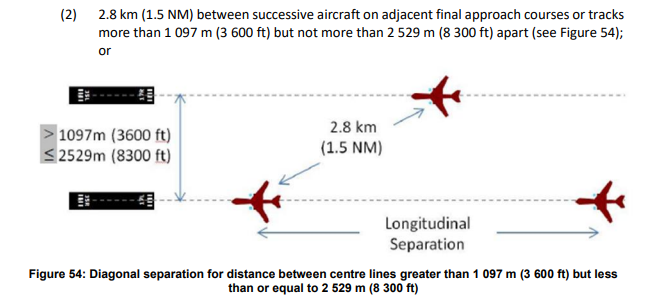](https://knowledgebase.vatsim-germany.org/uploads/images/gallery/2023-02/eddf-app-dependent.png)
Source: Regulation (EU) 2017/373, ANNEX IV — Part-ATS, 10.02.2023
It is very important not to drain out the final. Even if the Approach sector is too busy and traffic management holdings are necessary, usually there is no need to completely close sector entry for more than 5 minutes (around one orbit in the hold). After a short closure because of an overload on the Arrival/Director stations, it is recommended to set an aircraft rate per time, e.g. not more than one aircraft per 4 minutes via RASVO/IMCOM/ROLIS/KERAX and not more than one aircraft per 3 minutes via SPESA. Try to clear the holdings as quickly as possible. Due to the enormous capacity in parallel operations (up to 60 movements per hour), usually extensive holding usage is not necessary.
Besides the traditional holdings radar vectors along the downwind and final (without an approach clearance) can be used to delay inbounds as well. In this way, there is a lot of capacity to hold aircraft and it is easy to dissolve. It is recommended to use this procedure when the airport is completely closed for a short time. Do not have too many aircraft in this holding structure to make separation easy – the Center holdings can be used for any additional aircraft.
### Departure Procedures
Inbounds should stay above outbounds, clear of the Departure sector (at or above FL90). Outbound should stay at FL80 or below until they are clear of inbound traffic. If Departure and Arrival are staffed, a direct climb to FL110/FL130 can be coordinated if there is no conflict.
If the Arrival controller takes over the respective Departure sector, it is possible to let a departure climb above an arriving aircraft if the climb rate permits. Therefore make sure that at first inbound and outbound are vertically separated. Only when it is predictable that the outbound can overclimb the inbound, further climb should be issued.
Departing aircraft shall be handed over to the appropriate Center controller on the following flight levels to the following station:
| **Level** | **SID / Waypoint** |
| FL110 | CINDY / SULUS (out of RWY 18)
|
| FL130 | ANEKI / SOBRA / ULKIG / OBOKA / MARUN / TOBAK / SULUS (out of 07) |
All departing aircraft shall be handed over to the appropriate Center controller as early as possible, clear of any other traffic. **Traffic handed over from Departure to Center is fully released for further climb and turns.** Especially departing aircraft with the same routing, even for just some time, shall be separated by at least 10 NM laterally whenever possible. Otherwise, additional vertical separation shall be applied (e.g. for merging F and M/H routes if not solved by vectors, directs, or speeds).
### Modes of Operation
The runways system can be used in three different ways. This chapter explains these different modes of operation. In all systems, the main landing runways are 07R/25L and 07L/25R. Runway 07C/25C can be used as well (especially via visual swing-overs; see TWR SOP). In parallel operations, runway 07C/25C shall not be used by the Approach controllers and it shall not be used by the Tower controller for visual swing-overs two times right behind each other (swing-overs during 07 operations are only allowed for safety reasons anyways – see TWR SOP). If these rules are followed, visual swing-overs do not affect the following dependencies or independencies in any way.
Dependent operations are much easier to use but it does not have as much traffic capacity as parallel operations do. Usually, dependent operations are used on VATSIM. Especially during bigger events parallel operations may be the best way of handling the traffic.
#### Parallel Independent Operations
Arriving aircraft on runway 07L/25R are independent of arriving aircraft on runway 07R/25L as soon as they are established on the localizer.
1. The first Arrival controller to be contacted (not Director!) by the pilot assigns the runway. After the runway assignment, the handoff from one Arrival controller to another Arrival controller is necessary if the aircraft leaves one Arrival sector and enters another Arrival sector.
2. The pilot is handed over from the appropriate Arrival controller to the appropriate Director controller (Director North for all runway 07L/25R arrivals, Director South for all runway 07R/25L arrivals) no later than 10 NM before the expected turn onto the final (earlier handoff preferred).
3. Before hand-over from the Arrival to the Director controller, the aircraft must be instructed to descend to the intercept altitude (5000ft for 07L/25R, 4000ft for 07R/25L) whenever possible (this is strongly preferred!). If this is not possible, FL60/6000ft or higher could be used. Often it makes sense to instruct all pilots to maintain 220 KIAS before the handover to the Director controller.
4. The localizer or ILS clearance cannot be issued before the aircraft has reached the ILS intercept altitude.
5. Aircraft have to be at intercept altitudes inside the turn areas (see image). Any aircraft in the turn area not at intercept altitude has to be coordinated with both directors. If an aircraft is flying straight in and can not reach intercept altitude before entering the turn area, it has to be turned towards the downwind.
6. Outbound capacities can be reduced due to parallel operations. Target spacings (see above) should still be met wherever practicable.
With two Feeders it might be helpful to have all arrivals for runway 25L/07R (e.g. the ones not allowed on 25R/07L) on the southern downwind by clearing also arrivals from the north for the southern STAR. Inbounds from the north downwind for the southern runway will be handed over to FFS.
##### Procedures for parallel independent
- During this mode of operation, aircraft have to be able to fly 1 NM straight and level before intercepting the LOC and 2 NM straight and level before intercepting the GS (See ICAO DOC 4444).
- The Non-Transgression-Zone (NTZ) provided with the local Euroscope files defines a zone that must not be violated by approaching traffic. According to the ICAO definition, upon violation of the NTZ by one of the approaching aircraft, the aircraft in the adjacent approach must be instructed to perform a Go Around. It is not sufficient to instruct a Go Around for the aircraft violating the NTZ.
- The intercept of aircraft has to be performed so, that the aircraft establishes on the LOC inside the turn area.
- The line left of the turn area indicates the latest point at which an aircraft has to be established on the LOC, not below the published ILS intercept altitude, due to noise abatement reasons. Intercepts closer to the airport should be the exception if for example pilots overshoot the LOC and have to be turned back toward the ILS.
[](https://knowledgebase.vatsim-germany.org/uploads/images/gallery/2022-07/eddf-turn-areas-25.png)*Turn areas for 25 configuration (green)*
##### Staffing
Possible staffing configurations (no others are possible!):
1. **DFDN, DFAN, DFFN** (recommended if no more controllers are available but there is too much traffic for staggered operations. Otherwise use staffing option 2 or use staggered operations.)
2. **DFAN, DFAS, DFFN, DFFS** (DFDN, DFDS) (recommended!)
3. **DFAN, DFAS, DFFN** (DFDN, DFDS) (not recommended!)
4. **DFAN, DFFN, DFFS** (DFDN, DFDS) (usually not recommended!)
5. **DFAN, DFFN** (only in exceptional cases where there aren't more controllers but the traffic amount does not allow staggered operations. This should be changed back to staggered operations as soon as practical.)
*Station in brackets: additionally one or more of these stations can be staffed.*
If just one Director is staffed, he takes over the other Director.
DFAS and DFAN, DFFN and DFFS as well as DFDN and DFDS can be interchanged if one of the frequencies is preferred due to the neighbor station.
In real life parallel operations can only be used with two Director controllers. On VATSIM parallel operations with only one director is possible if necessary, but not recommended. With two directors, only parallel operations are possible.
#### Dependent Operations
Arriving aircraft on runway 07L/25R are dependent to arriving traffic on runway 07R/25L. However, the separation for aircraft established on the parallel runways can be reduced to 1.5 NM. Wake turbulence separation has to be given at any time for aircraft approaching the same runway. It is also important that all aircraft have to fly a precision approach. If an aircraft is unable for a precision approach, it is required to switch to alternating operations for this aircraft.
##### Procedures
Director assigns the runway on the initial contact or very soon thereafter.
The handoff from Arrival to Director should take place no later than 10 NM before the expected turn onto the final (earlier handoff is preferred when able).
##### Staffing
Possible staffing configurations (no others are possible!):
1. **FAN** (FFN, FDN, FDS)
2. **FAN, FAS, FFN** (FDN, FDS) (not recommended!)
Station in brackets: additionally one or more of these stations can be staffed. FAS and FAN, FFN and FFS as well as FDN and FDS can be interchanged.
#### Alternating Operations
All arriving aircraft must maintain radar separation. Reduced Minimum Radar Separation (RRS) can be applied if necessary.
##### Procedures
Director assigns the runway on the initial contact or very soon thereafter.
The handoff from Arrival to Director should take place no later than 10 NM before the expected turn onto the final (earlier handoff is preferred when able).
##### Staffing
Possible staffing configurations (no others are possible!):
1. **FAN** (FFN, FDN, FDS)
2. **FAN, FAS, FFN** (FDN, FDS) (not recommended!)
Station in brackets: additionally one or more of these stations can be staffed. FAS and FAN, FFN and FFS as well as FDN and FDS can be interchanged.
### Minor Airports within the TMA
#### Egelsbach
Egelsbach (EDFE) is an uncontrolled airfield within the Frankfurt TMA. Egelsbach is handled the same way as any other uncontrolled airfield. If Egelsbach Radio is offline, it can be handled by DFAS if this controller has the VATSIM AFIS endorsement. Egelsbach airport can be delegated to Frankfurt Tower if this controller has the AFIS endorsement. If no controllers have the AFIS endorsement, Egelsbach airport cannot be covered with AFIS service.
Although Egelsbach is an uncontrolled airfield, a big ratio of the traffic is business traffic. This traffic is usually IFR but must depart or land VFR in Egelsbach. Standard procedures for IFR pickup or IFR cancellation apply. It is recommended to execute IFR cancellations southeast of EDDF at 4000ft or below. It is also recommended to instruct pilots inbound Egelsbach to leave airspace CHARLIE to below as soon as IFR is canceled.
Charts are available in the [AIP VFR](https://aip.dfs.de/BasicVFR/pages/C019C6.html "DFS AIP VFR EDFE").
#### Wiesbaden
IFR in-/outbounds to Wiesbaden (ETOU) need to be separated to Frankfurt in-/outbounds. Coordination between Arrival and Frankfurt Tower might be necessary.
An ILS approach is only available for runway 25 while both runways have RNP and TACAN approaches.
Wiesbaden's extended Northern pattern enters airspace D above the Wiesbaden CTR up to 2100ft. If use of the extended pattern is required, Wiesbaden Tower will request approval from DFAN.
IFR departures out of Wiesbaden are initially cleared to the final waypoint of the SID by Wiesbaden Ground. Further clearance to the destination is required once the aircraft is handed off to Langen Radar.
> **DUKE31**: Langen Radar, Duke 31, 2300ft, climbing 5000ft. **Langen Radar**: Duke 31, Langen Radar, identified, climb to FL130, cleared to Stuttgart via flight planned route.
> **DUKE31**: Duke 31, climbing FL130, cleared to Stuttgart via flight planned route.
Charts are available via [MILAIS GEMIL FLIP US DoD](https://www.milais.org/publications.php "MILAIS Publications").
Wiesbaden arrivals sometimes need to be descended earlier than Frankfurt arrivals to ensure a manageable descent profile. The following table shows some **tips on how to achieve this**.
| **Runway**
| **Direction**
| **Routing and descent profile**
|
| **07**
(RNP)
| from the Northwest
| direct to OU452 to cross OU452 at 5000ft, from OU452 cleared for the approach
|
| from the Northeast
| direct to OU455 to cross OU455 between 5000ft and 7000ft, from OU455 cleared for the approach
|
| from the South
|
| **25**
(ILS)
| from the Northwest
| direct to TAU to cross TAU between 5000ft and 8000ft, from TAU cleared for the approach
|
| from the Northeast
| direct to OU117 to cross OU117 between 4000ft and 7000ft, from OU117 cleared for the approach
|
| from the South
| direct OU115 to cross OU115 at 4000ft, from OU115 cleared for the approach
|
### Coordination
Before any session, the following coordination must be made:
**With Tower:** Runways in use (TWR decision), current ATIS information (TWR decision), mode of operation (APP decision)
**With Center:** STARs to use (APP decision), holdings usage (only if necessary – APP and CTR responsibility but APP decision)
All handovers are carried out as silent handovers as long as the relevant LOAs or additional agreements do not define a different procedure.
# EDDF - DeIcing
At Frankfurt de-icing is done around 50% at the parking position and 50% remote on the deicing pads. All outbounds should request remote deicing if required prior startup! Depending on the aircraft type (3/4 engine or A388) and departure runway (25C), remote deicing request can be denied and the outbound has to deice on position prior pushback.
### De-Icing Pads
For **departures out of runway 18 (and 07) DP1 and DP2 are primary used**, while for **departures out of runway 25/07 DP4 (and DP3)** are prefered if deicing on the position is not possible. Most of the pads have an east and west part, where simultanious de-icing is possible.
| **DP** | **Location** | **max. Usage** |
| **DP1** | west of runway 18
| **Code E +** B748
|
| **DP2C** | west of runway 18
| **Code E +** B748
|
| **DP2E / DP2W** | west of runway 18
| **Code C** (B739/A321)
|
| **DP3E / DP3W** | N7 blue/orange - **facing north** (!)
| **Code C** (B739/A321)
|
| **DP4E / DP4W**
| V159 / V161- **facing south** (!)
| max. 2 engined heavies
|
| **DP5** | G16A
| not used
|
Outbounds on the southern apron need to use one of the pads on the northern side if deicing on the position is not possible.
**A380s** have to **de-ice on position** prior pushback!
As soon as the aircraft is on the pad the pilot need to contact the "ice house" to coordinate the deicing process and further details (no Apron duty). After deicing the outbound needs to contact Apron again for further taxi to the holdingpoint.
> **Frankfurt Apron**: DLH123 continue to DP2 Center, hold abeam the eyeline and contact ice house.
Icehouse (all deicing duties itself and communication with the pilot) is not simulated at Vatsim Germany!
### Pad Usage
Outbounds with **3 or 4 engines** departing **runway 25C** should always be **deiced on position** prior pushback!
**DP1:** Primarily used for heavy traffic (prefered for 3/4-engine) for runway 18, possible for traffic departing runway 07C.
**DP2:** Pad East and West is primarily used for traffic departing runway 18 and can be used for traffic departing runway 07C when required. DP2C is rarely used and only if no code C aircraft is waiting for de-icing.
**DP3:** This pad is not prefered and should only be used when there is to much traffic for DP4 or DP1/DP2. Usually only used for traffic departing runway 25C/07C. When one of the pads is used, it's not possible to taxi via N7-orange/blue at all. Center Apron is always responsible for traffic to and from DP3.
**DP4:** Prefered for departing traffic out of 25C/07C, but can be used for traffic departing runway 18 as well. Center Apron is responsible for traffic to the de-icing pad. Traffic leaving DP4 need to be coordinated or transfered to West Apron for taxi out.
### De-Icing Apron
This position is only staffed during a high demand of remote deicing at DP1 and DP2. When the station is not staffed, West Apron is responsible for traffic to and from DP1 and DP2.
De-Icing Apron is **only responsible** for traffic sequencing planned on **DP1 and DP2** as well as the Apron area at N-North/P1 (incl. F231 - F238 and V266 - V270).
**[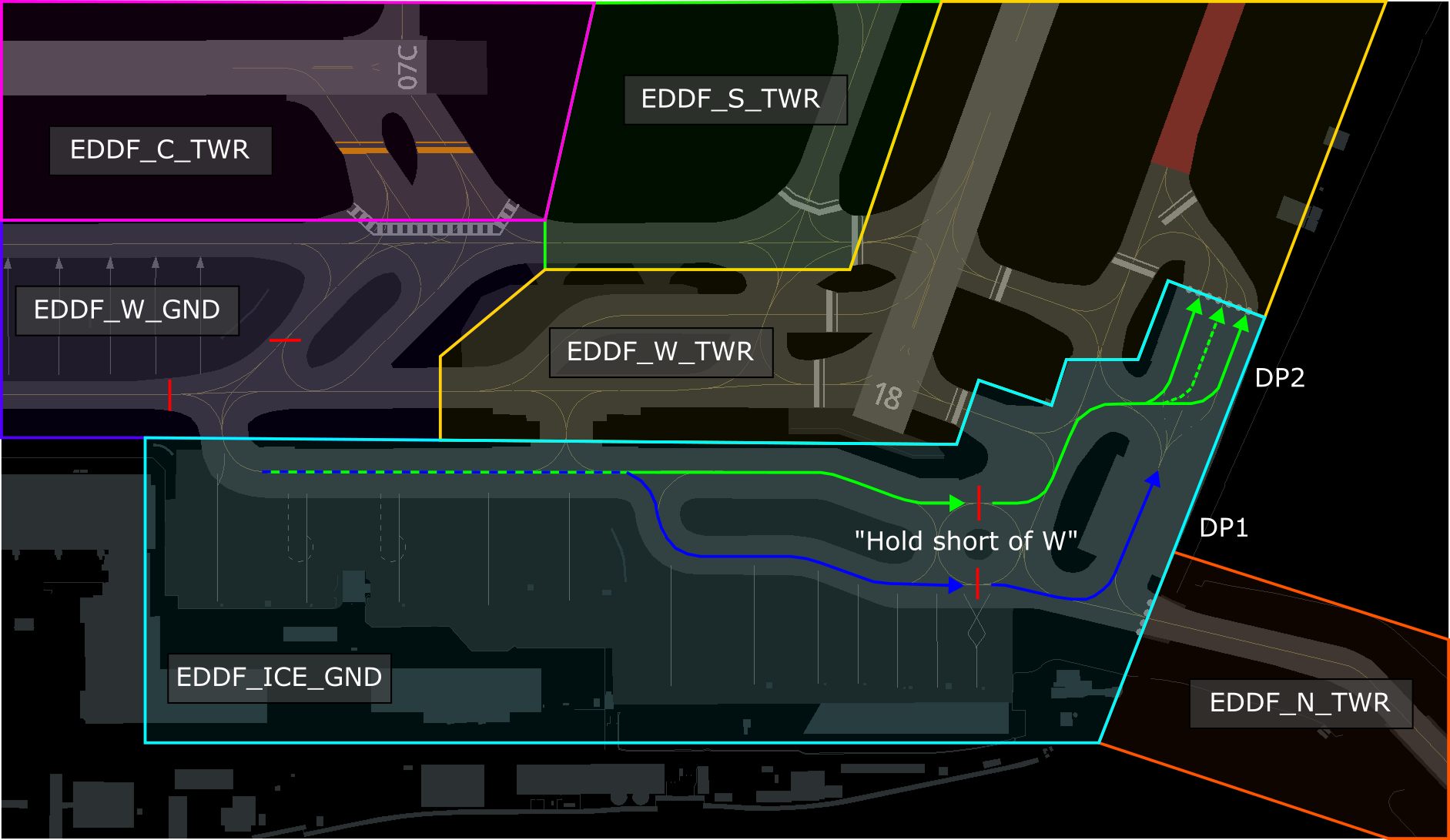](https://knowledgebase.vatsim-germany.org/uploads/images/gallery/2025-01/eddf-ice-gnd-aor.png)** *AoR De-Icing Apron*
Inbounds and traffic for the pads is handed over from West Apron free off conflicts short of N15/N. Outbounds for DP1 and DP2 will not cross runway 18, they always have to use N-North/P1! Outbounds on the positions in this area are handed over from Delivery direct to De-Icing Apron.
**Handoff Tower:** Outbounds from DP1 are send by Apron to W1 (18 departure) or W3 (07 departure for crossing runway 18) free of conflict. Outbounds from DP2 need to contact Tower to continue taxi to W3. All traffic is send to DFTW.
**07 Departures:** All 07C departures from DP1 and DP2 have to cross runway 18 via W3 - L. **Apron West is responsible to keep L** between runway 18 and L21 **clear** for traffic to runway 07C.
P1 can be closed on request by De-Icing Apron when to much traffic is waiting for deicing on P1/N-North.